On most global airline rankings, a few elite airlines reign supreme. In recent years, Qatar Airways and Singapore Airlines have duked it out for the top spot. That pair of long-haul carriers are on top of their game, especially in premium cabins where they can dial the experience up to the max.
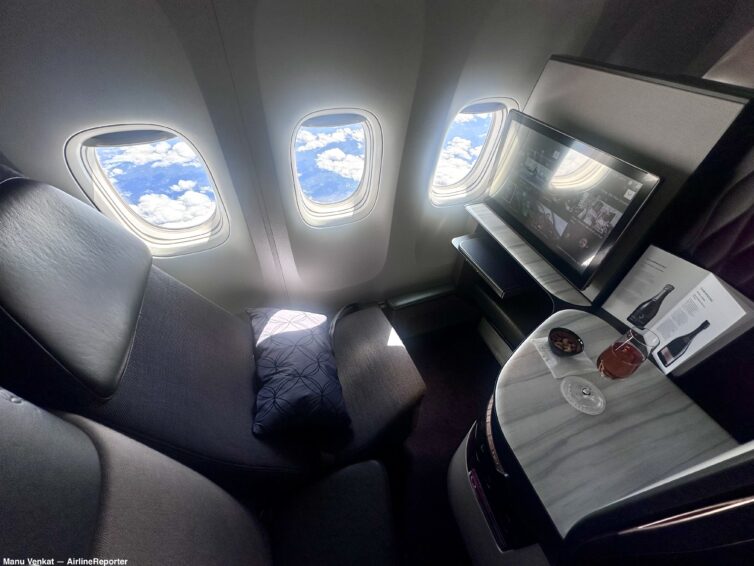
I’ve enjoyed writing occasional airline comparison stories like Air France vs KLM (2020) and a battle royale between five Star Alliance carriers (2018). This past year I was fortunate to fly long haul itineraries on both Qatar and Singapore. And to follow up the individual stories on each experience (Singapore JFK-SIN, Qatar JFK-DOH) it felt right to pit these two heavyweights against each other.
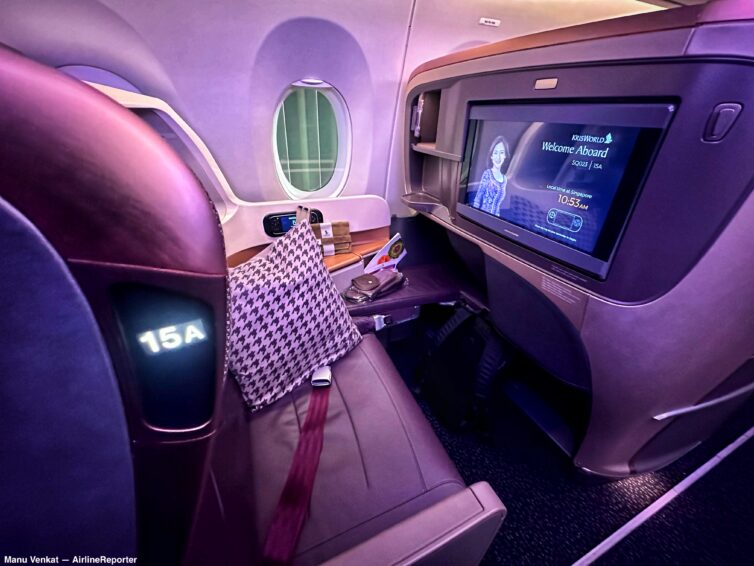
In this story I compare Singapore and Qatar on the basis of seats, service, food, drink, entertainment, amenities, and the ground experience at their respective hubs. And at the end, I do my best to crown a champion. That last task was tough, because it ended up being a VERY close fight.
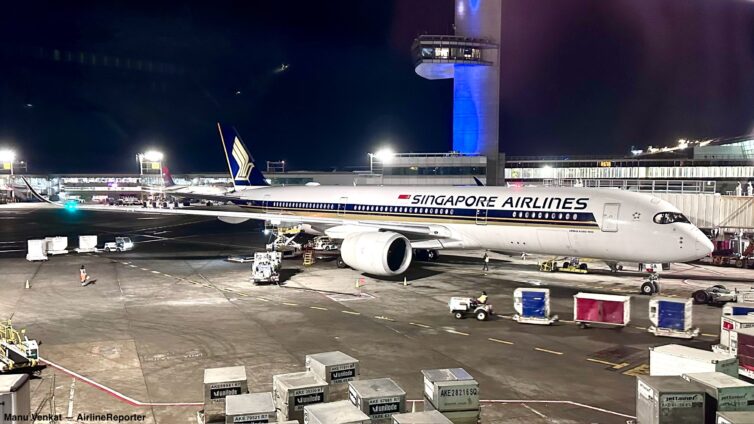
Whether you’re a seasoned road warrior, an aspirational fancy flyer, or you just like pictures of pretty planes, you’ll enjoy this story. So click / scroll below and read on!
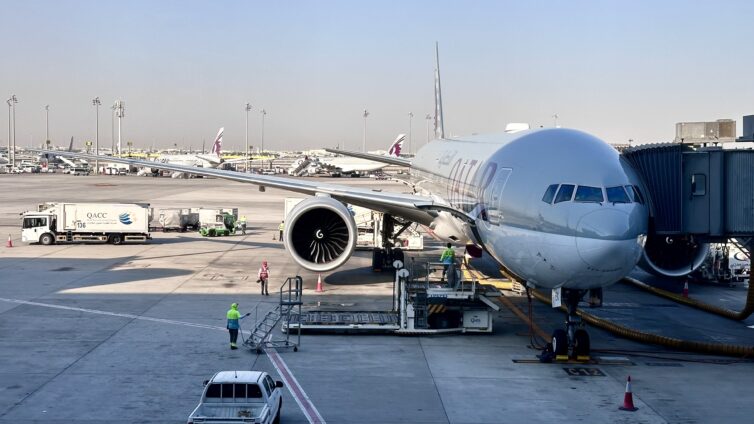
Rules for a fair fight
Before launching into the heart of the story, a few ground rules and disclaimers. First, I’m not pretending to be a super-frequent flyer on these airlines. (Side note: if you know how I can become that kind of person, please let me know). But I did fly multiple long-haul routes on each airline — enough to make a meaningful comparison.
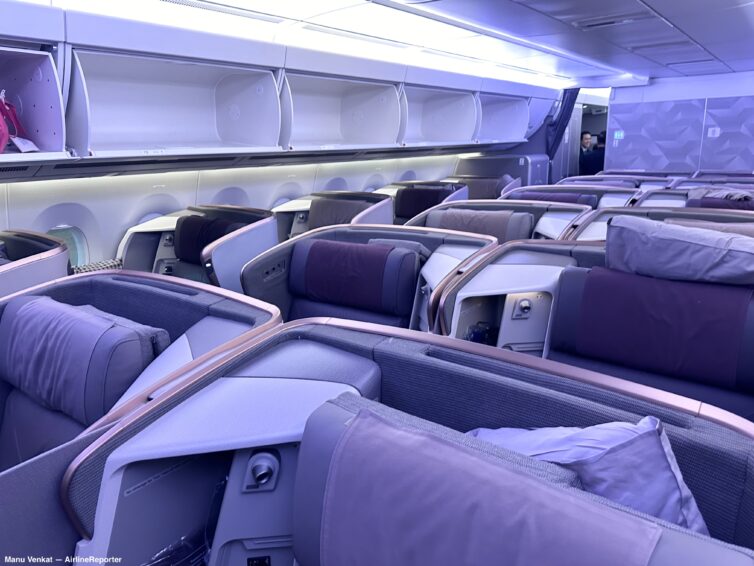
For the sake of a fair comparison, wherever possible I focused on the longest-haul flight I took on each airline. In Qatar’s case it was a 777-300ER Qsuite flight from New York to Doha, clocking in at 12 hours. And for Singapore, it was actually the world’s longest flight: 19 hours on an A350-900ULR from New York JFK to Changi International.

Another caveat: these are two massive airlines that each offer a variety of onboard products, plane types, and destinations. What I experienced on my flights may not apply to your experience flying the same airlines. And it goes without saying that this sort of comparison is highly subjective. I’d honestly love to hear all the ways you may disagree with me (the comments section awaits!).
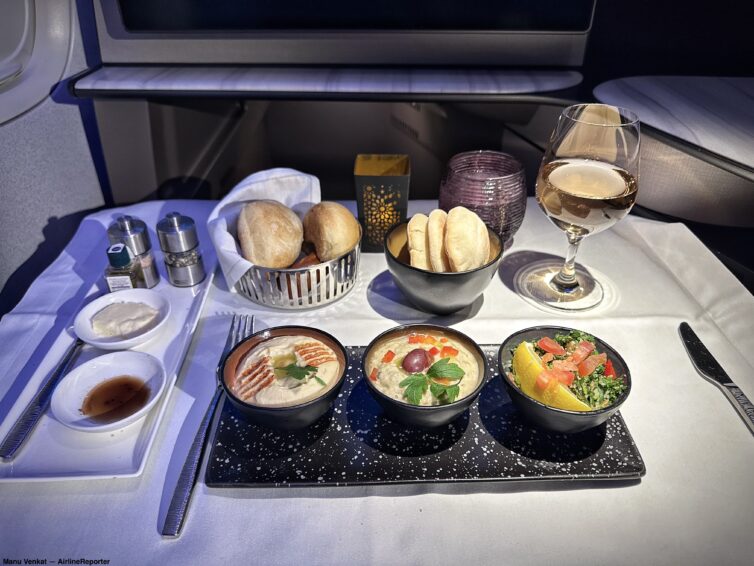
Finally, I recognize that stories nitpicking and judging premium cabin flying can seem obnoxious. Feel free to roll your eyes and skip this story if it’s not your sort of thing. That said, I think we AvGeeks are extra appreciative of the incredible experiences airlines manage to deliver within the confines of a pressurized tube miles above the ground. Flying in such style is like watching a seasoned orchestra perform. It never ceases to amaze.
Ok, without further ado, it’s time for the battle to begin!
The seat
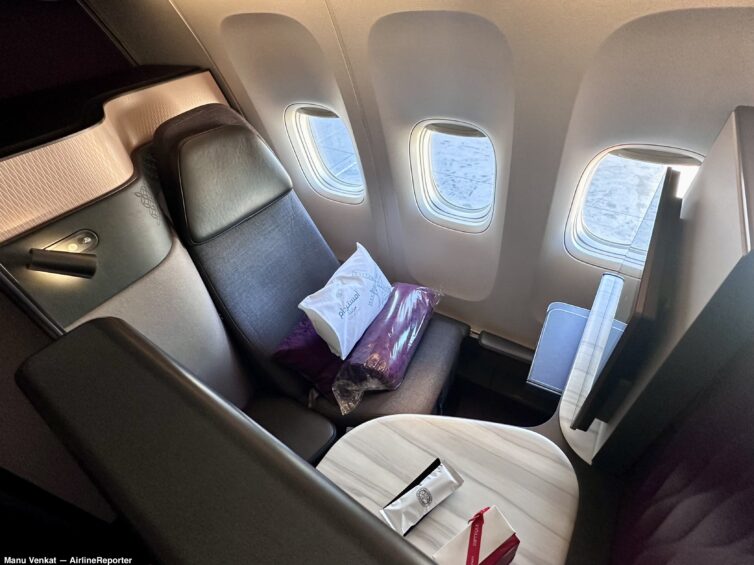
Qatar’s reputation leans heavily on its long-haul Qsuite business class design. As a fully enclosed seat with a door, the product offers plenty of room and privacy.
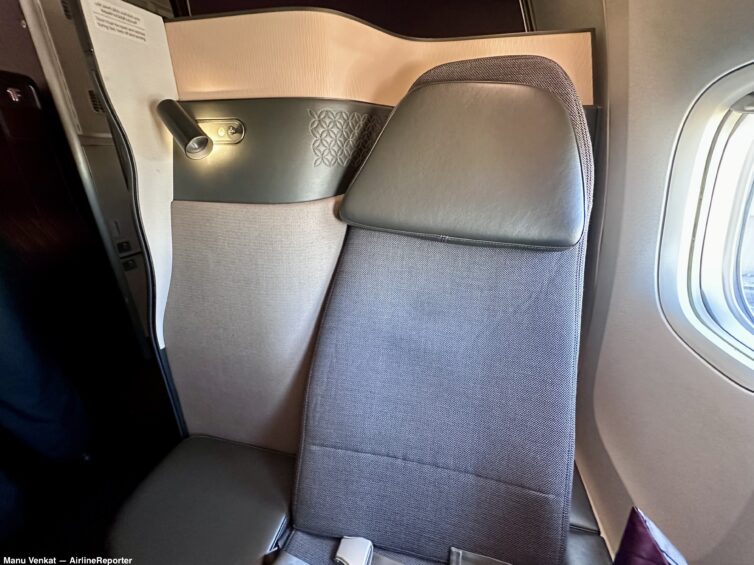
The cabin finishes are tastefully done, with lots of subdued browns/greys and burgundy accents. Even eight years after its initial rollout, this seat design still holds its own against the best of ’em.
The seat goes fully flat and is comfortable as a bed.
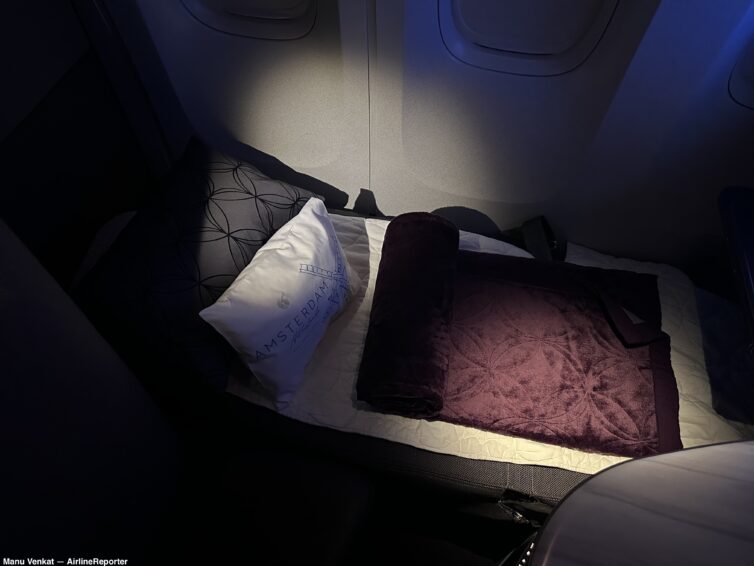
Qsuite boasts the ability for certain clusters of four seats to open up and become a shared “quad.” I’m not sure how often people take advantage of that, but it at least represents some creative design thinking.

There are just a few Qsuite downsides. Thanks to high walls, the doors, and Qatar’s decision to keep overhead bins in the center section, Qsuite may strike you as more confined. Also, half of the cabin’s seats face rearward. There’s a novelty factor in facing the tail while flying, but once the novelty wears off you may find that you’re not a fan.
In our other corner, Singapore Airlines hasn’t (yet) adopted suite-style seats, but it’s product is roomy, luxurious, and has a proven track record.
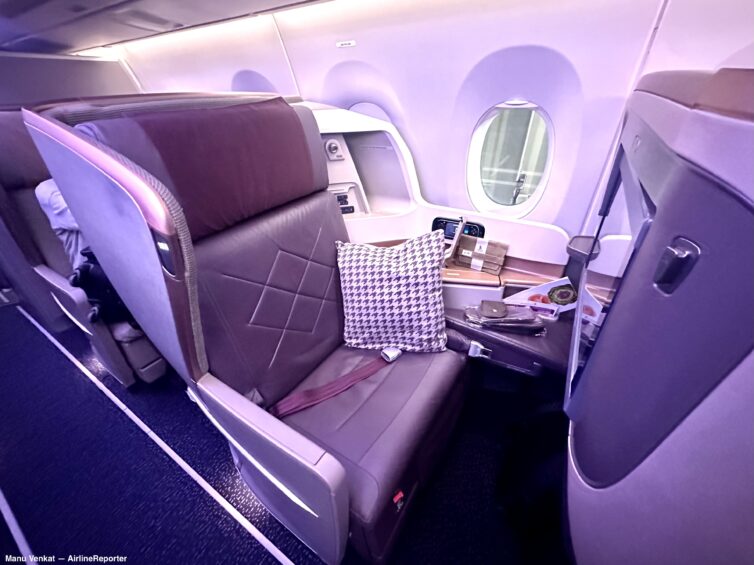
Singapore offers a similar style of seat across much of its long-haul fleet — generally in a 1-2-1-across configuration. The product looked especially nice on the A350-900ULR I flew on.
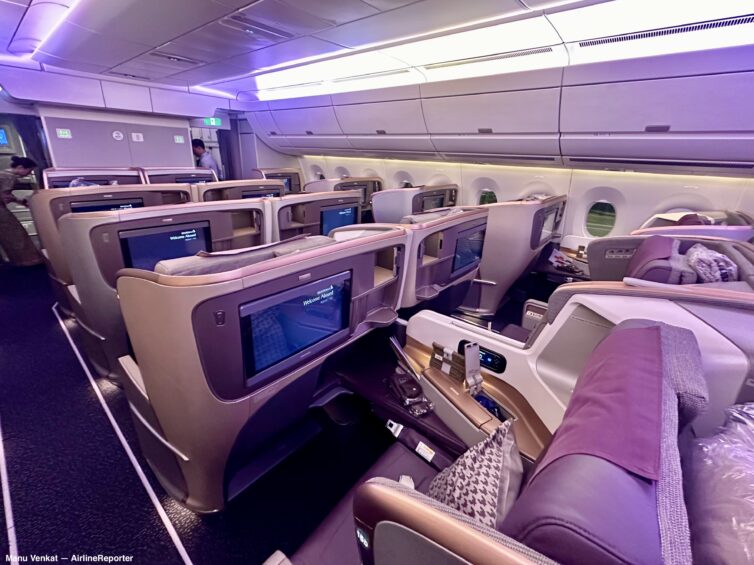
The seatback itself measures an impressive 28 inches wide — significantly wider than Qsuite’s.
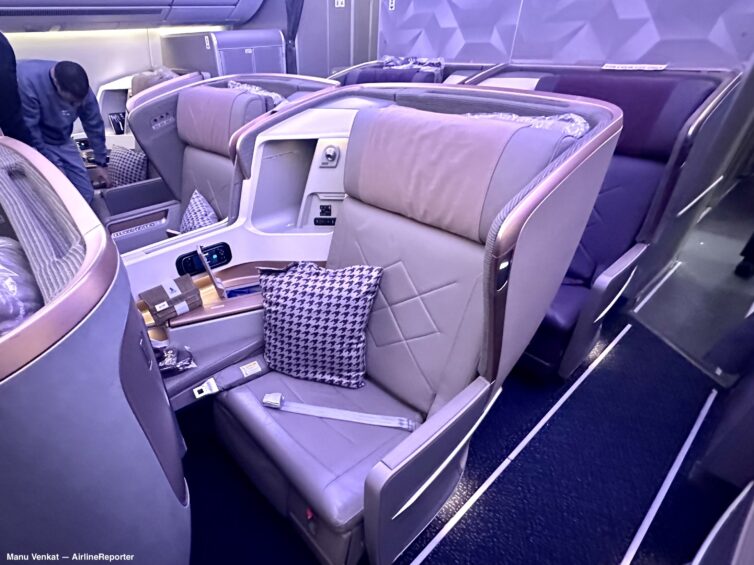
One odd thing about the seat is that you can’t convert it to fully-flat mode yourself. The entire seat flips forward to open up the bed, a process that requires a flight attendant’s involvement. That design allows the airline to optimize the seat surfaces for each phase of flight, with a soft bed surface and firmer upright seat surface. But that benefit comes at the expense of your ability to independently switch between the two modes.
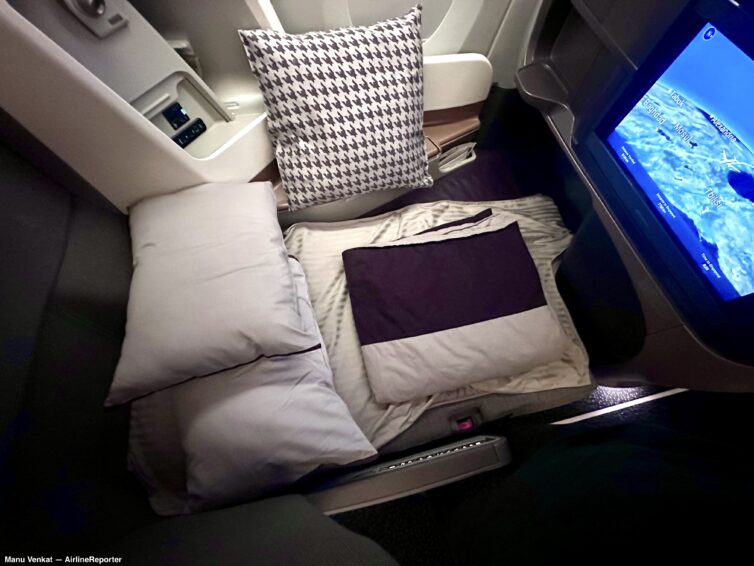
The winner: Qatar
It’s a close call, but Qsuite is just too good. Suites with doors have become a mainstay of the business class seat elite. And in addition to their doors, Qatar’s seats excel across the board in layout, decor, and functionality.
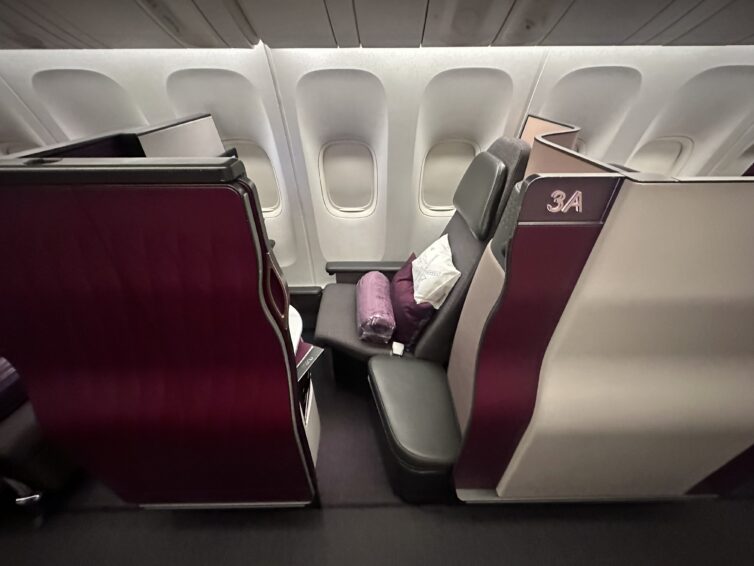
As great as Singapore’s seats are, there’s no getting around the fact that they’re much more exposed.
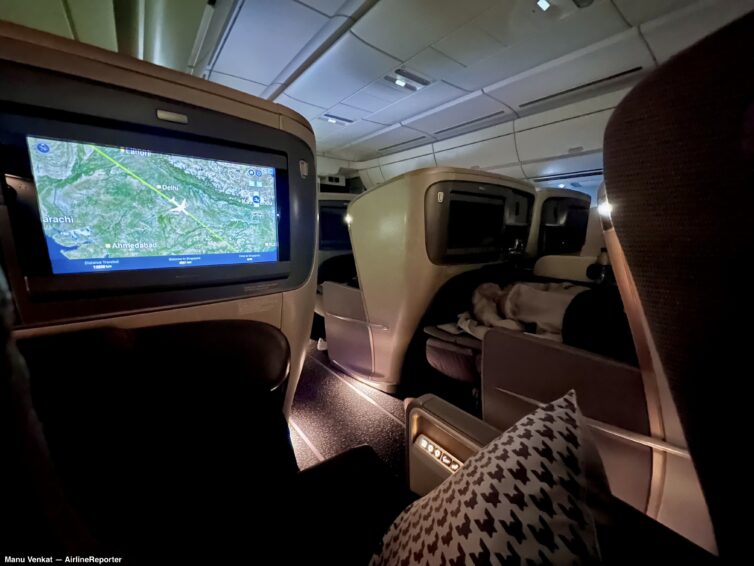
Last year Singapore hinted that it’s working on a next-gen business class seat with doors, so the seat design category is going to be even more competitive in the future.
Dining
Switching over from hard product to soft product, food is one of the main ways an airline can make or break your premium cabin inflight experience. And both of our competing airlines do a stellar job with dining overall. They both serve food directly onto your table, instead of bringing over trays or serving off a cart.

Qatar offers a fully on-demand dining structure, meaning you aren’t constrained by predetermined mealtimes. The flexibility is great, though in practice most people end up eating an after-takeoff meal just like you would on other airlines. You can also pre-select your preferred entree option online in advance.
Qatar’s meal service is ambitious, in terms of both the dine-on-demand model and the menu of dishes on offer. In reality, at least based on my personal experiences, the execution can be hit-or-miss. For example, the lobster I got after takeoff was plated beautifully but was overcooked to the point of being hard as a rock.
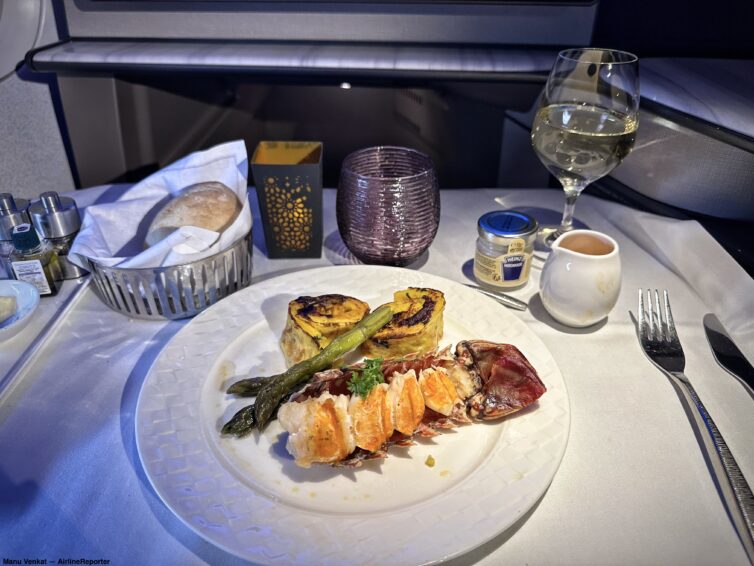
But then my second meal later in the flight was absolute perfection, in both presentation and taste.
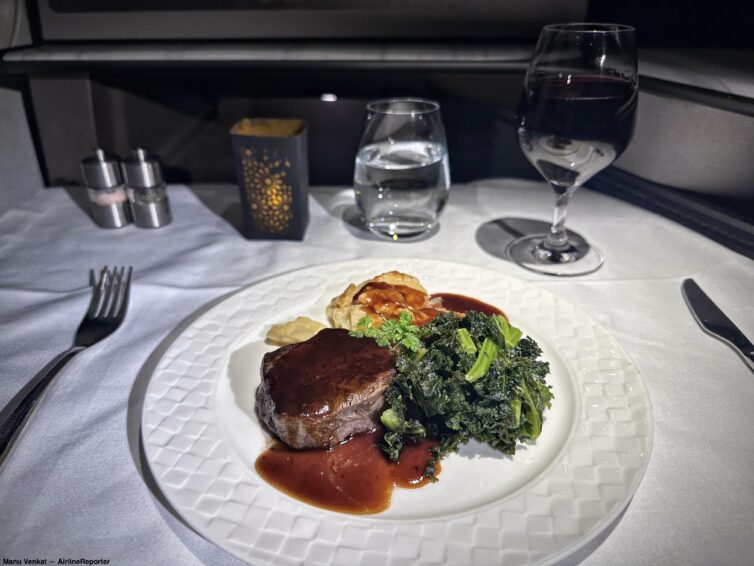
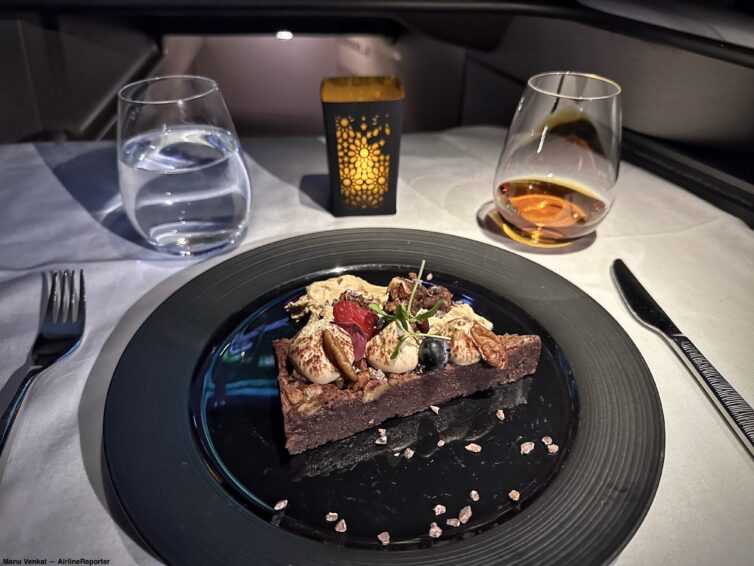
Qatar made waves last year when it started rolling out caviar service on many of its long-haul departures from Doha. It’s an impressive feature for business class, since you more commonly see caviar as a first class perk.
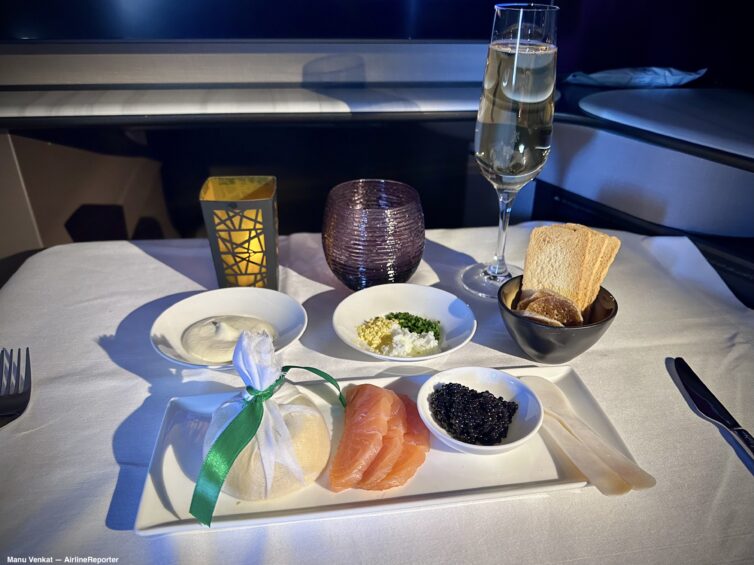
I’m not going to pretend to be a caviar connoisseur, but it sure was fun to try.
On Singapore’s side, they serve up some amazing in-flight cuisine as well. They’re well known for their Book the Cook service that allows you to pre-select entrees from an expanded list of options. The selection is broadest if you’re on a flight departing Singapore, but departures from many other destinations have access to some additional Book the Cook meal options as well.
Even premium economy passengers can book the cook — I pre-reserved the very tasty meal below on a long-haul premium economy flight.
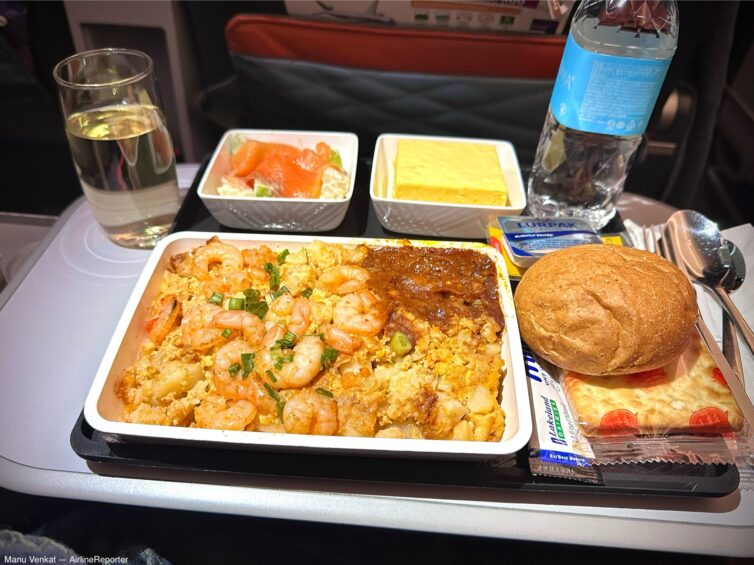
But back to biz class: Singapore runs cool catering partnerships like this salad supplied by the innovative indoor vertical farming company AeroFarms.
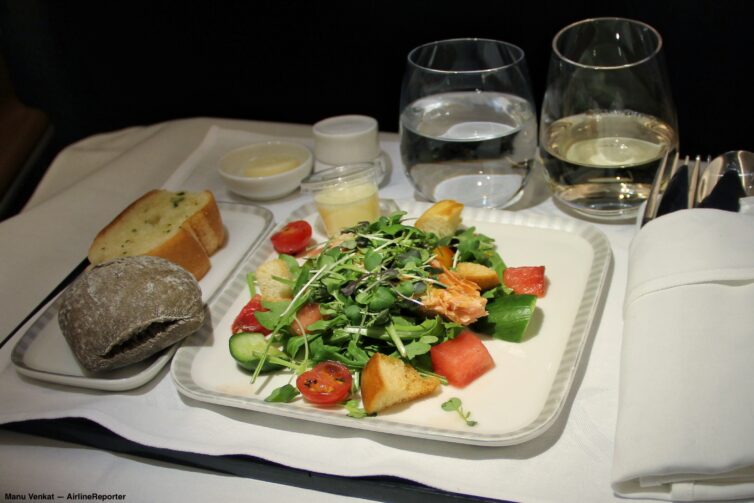
And then later in the flight I tried Moroccan grilled lamb chops that were a collaboration with California’s Golden Door spa and wellness retreat.
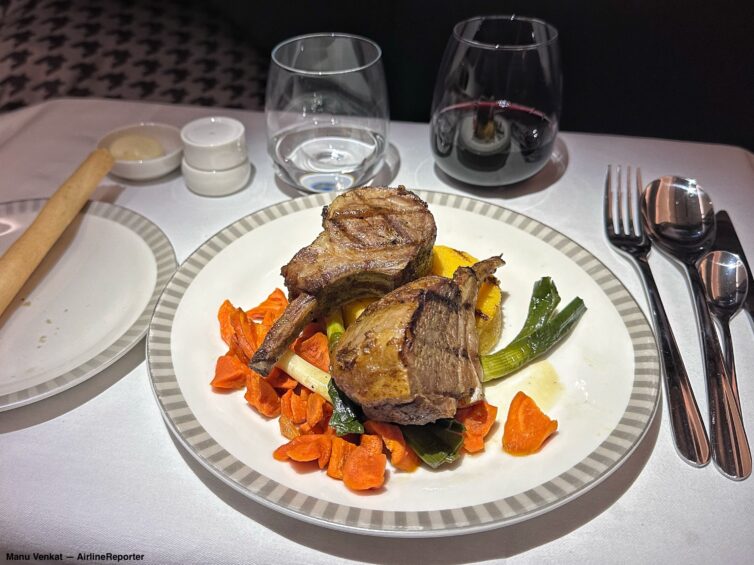
The airline serves up pretty great cheese and dessert options too.
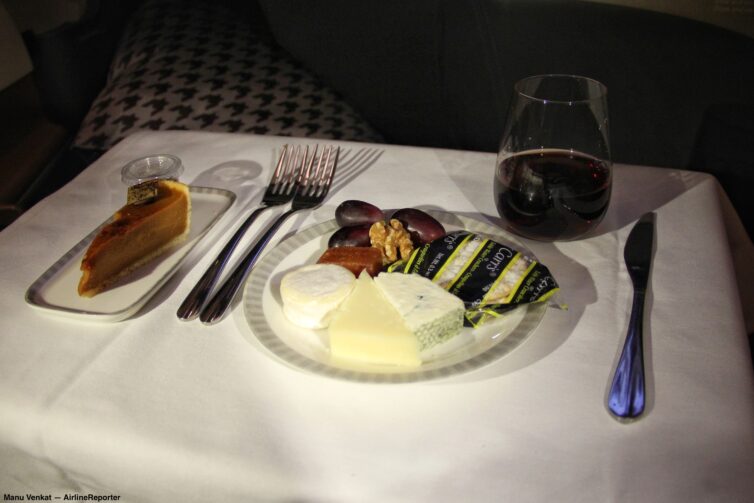
Singapore doesn’t offer a fully on-demand dining model, though there is some flexibility. At our flight’s halfway point, the crew turned on the cabin lights for a second meal. But for anyone who kept sleeping, there were still hearty food options available throughout the second half of the flight.
One strange menu design choice on our 19-hour Singapore flight was the lack of a real breakfast dish.
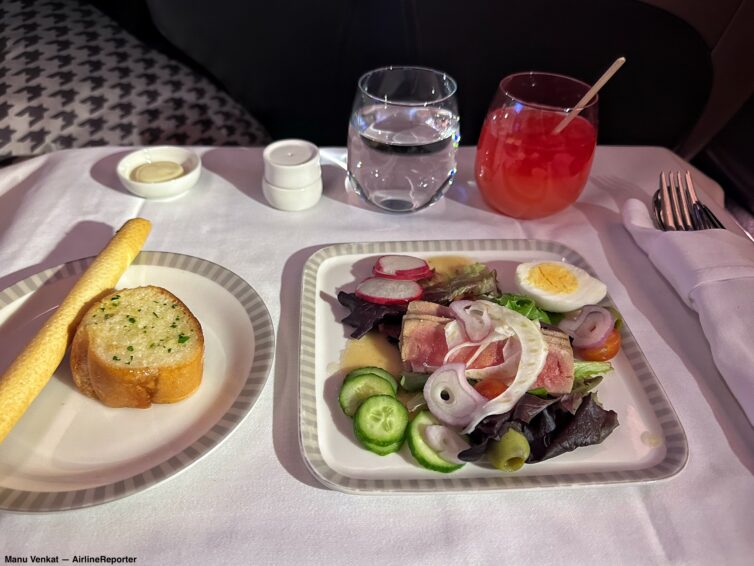
Winner: It’s a tie
I really wanted to avoid ties in this story, but this category felt like it had to be a draw.
Qatar’s fully on-demand meal service and caviar service are incredible. But the occasional misfires on execution dragged the experience down a bit.

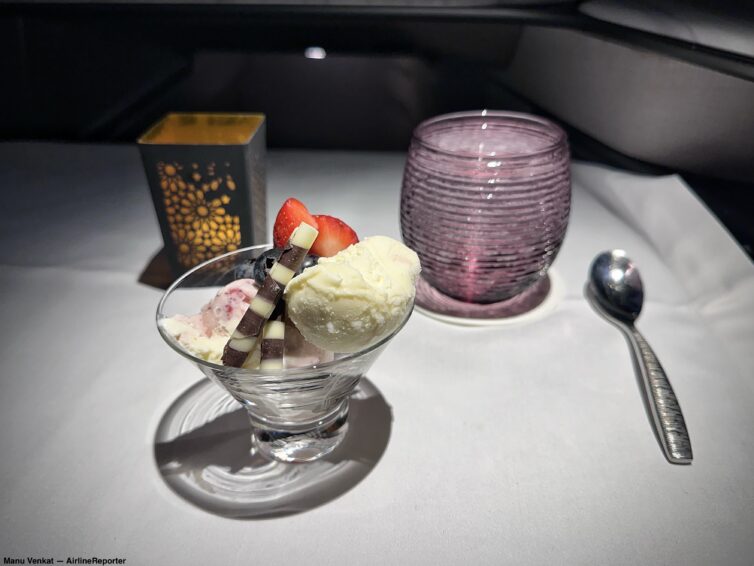
Singapore didn’t have as much wow factor with any individual dish, and its service style isn’t as flexible as Qatar’s dine-on-demand model. But Singapore’s execution was more consistent, and Book the Cook provides an impressive variety of choices.
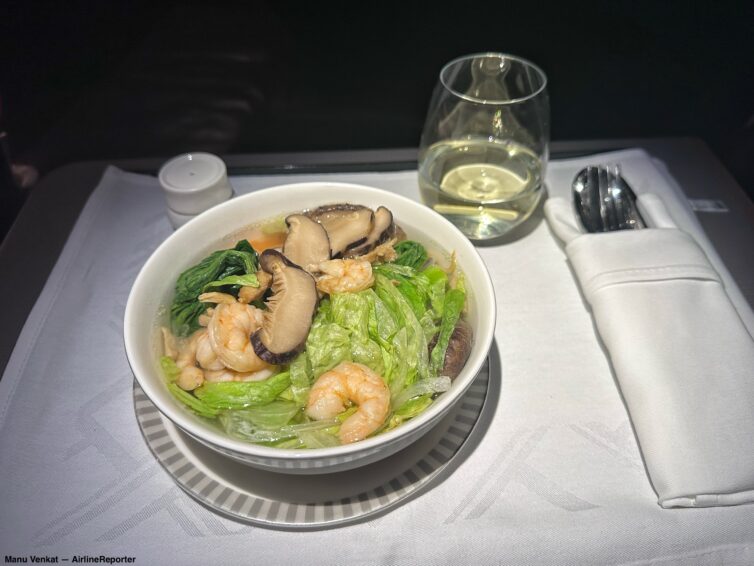
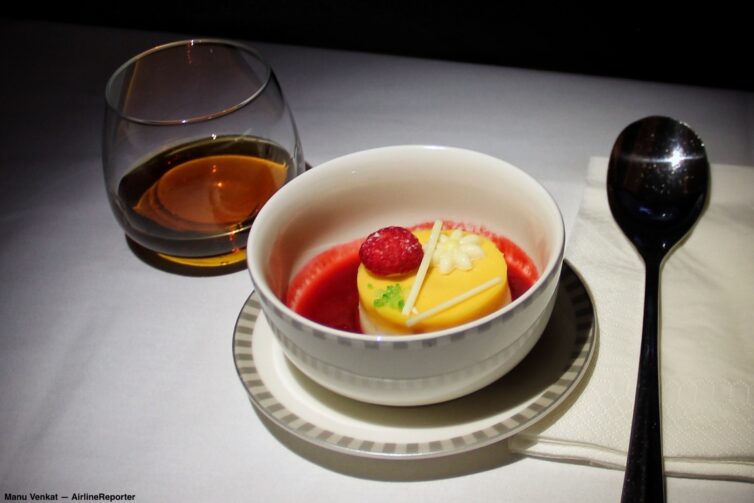
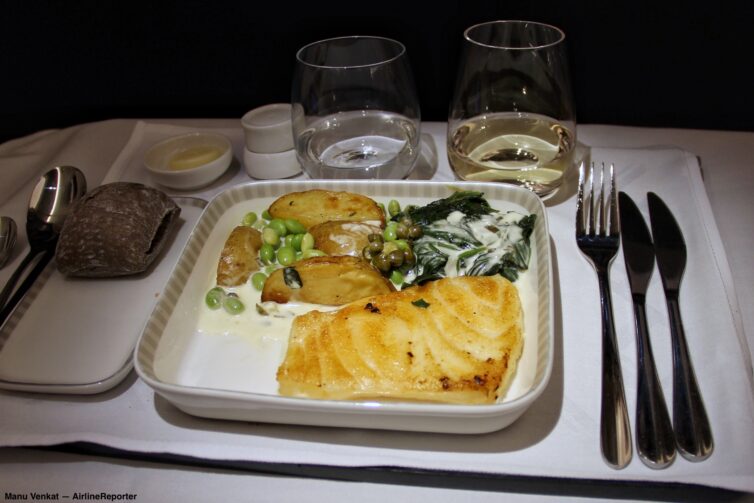
Even drawing in data points from my other flights with both airlines, I really couldn’t fairly name a winner either way. We’ll call it a tasty tie, and move on to the next category.
Drinks
Why do drinks get their own category? For one, a wine list is a concrete way to quantify an airline’s investment in its onboard experience. Also, many airlines get creative with their beverage offerings, showcasing unique flavors from their home countries.

Traditionally champagne is the highest-profile prestige item on the menu. Singapore was serving 2018 Piper-Heidsieck when I flew them. That’s an impressive choice even compared with what’s offered on the world’s other best business classes.
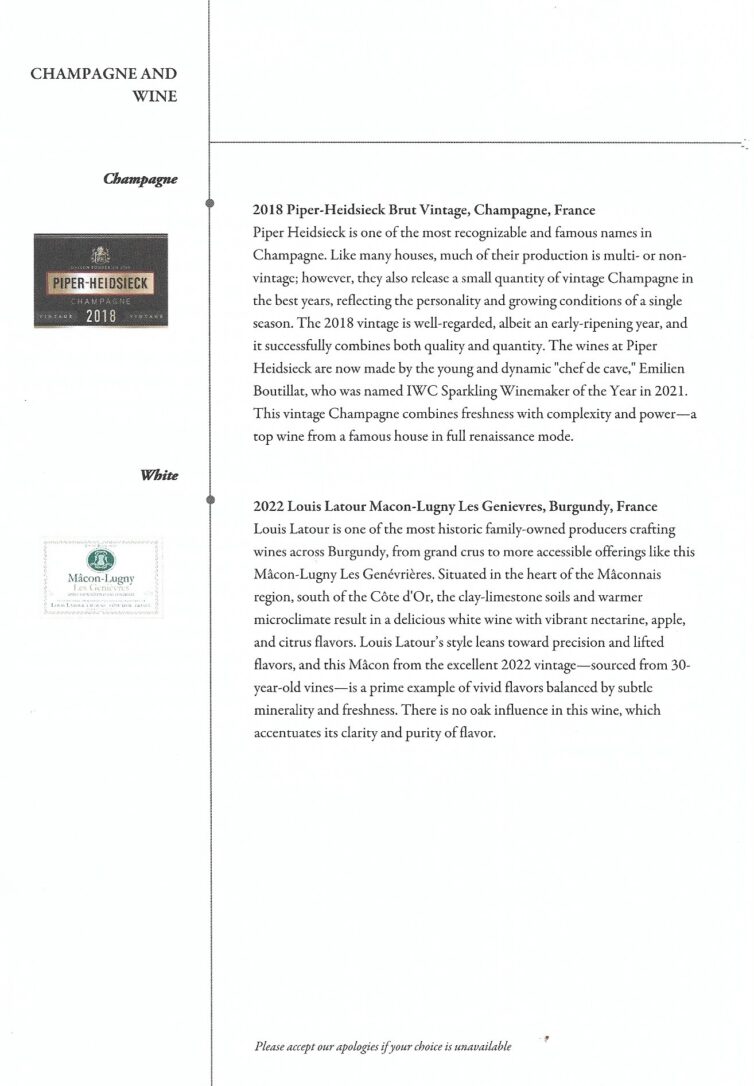
The cocktail list features a hometown favorite, the Singapore Sling. The airline’s version is on the sweeter side, but tasty.
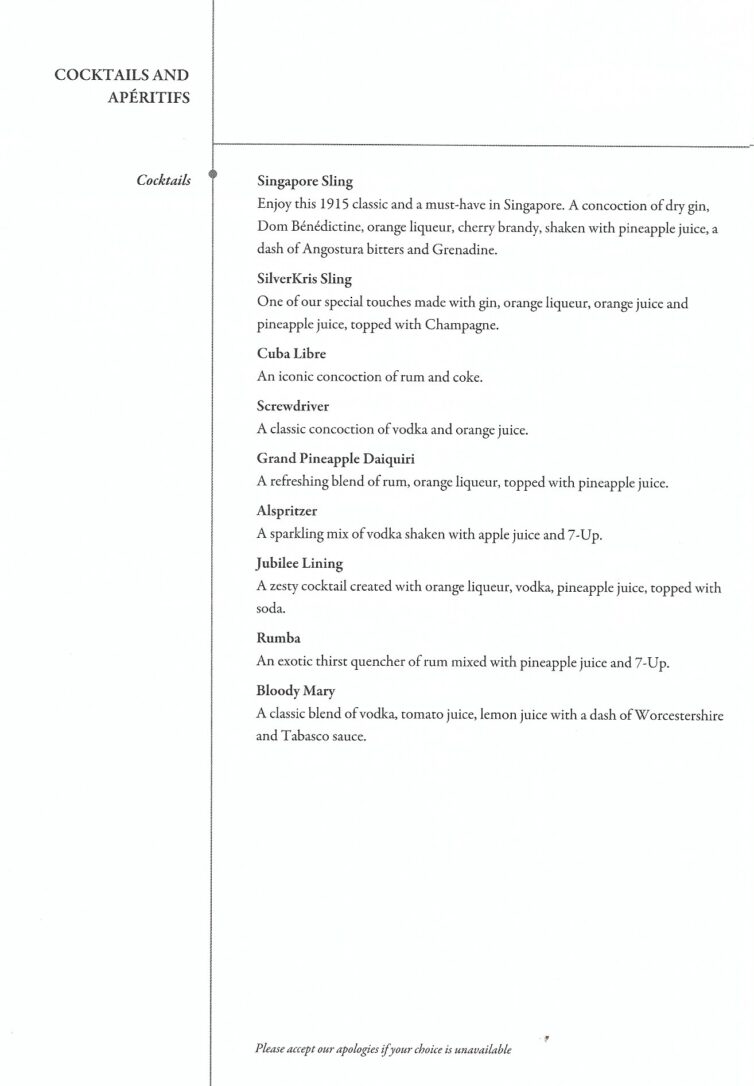
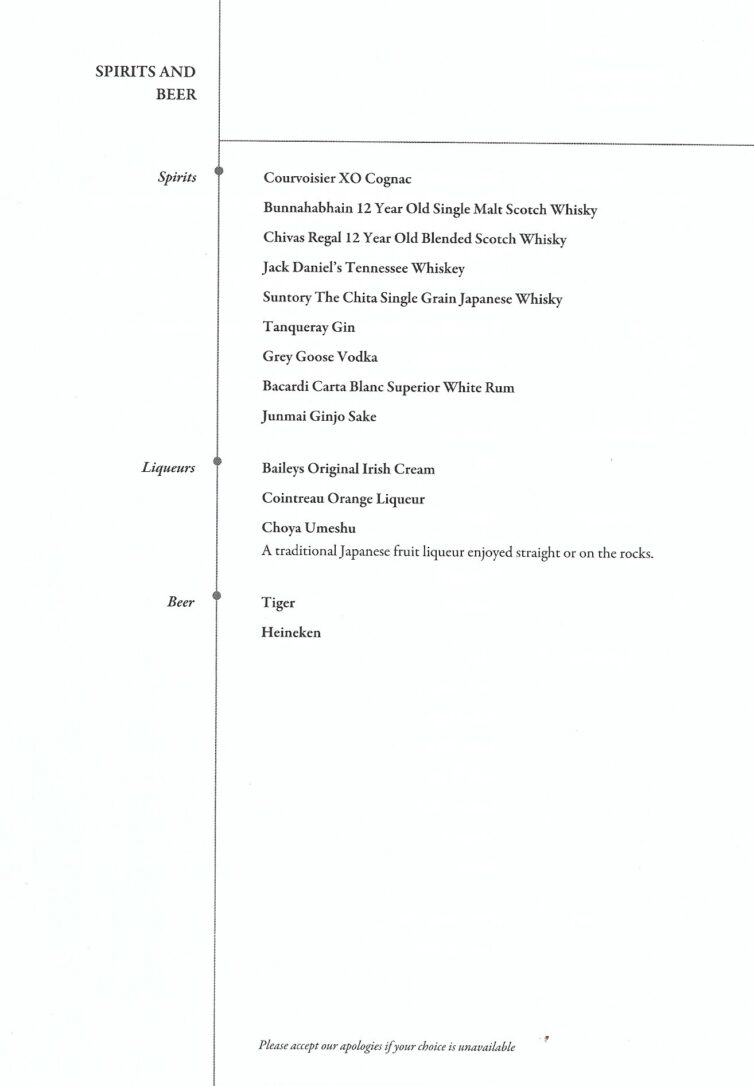
Singapore also gets kudos for a thoughtful mocktail list. There’s a growing sober-curious movement out there. And even for people who drink, there’s a strong case to be made for avoiding alcohol during flights (less dehydration, improved sleep). So it’s nice to see the airline providing some thoughtful non-alcoholic options.
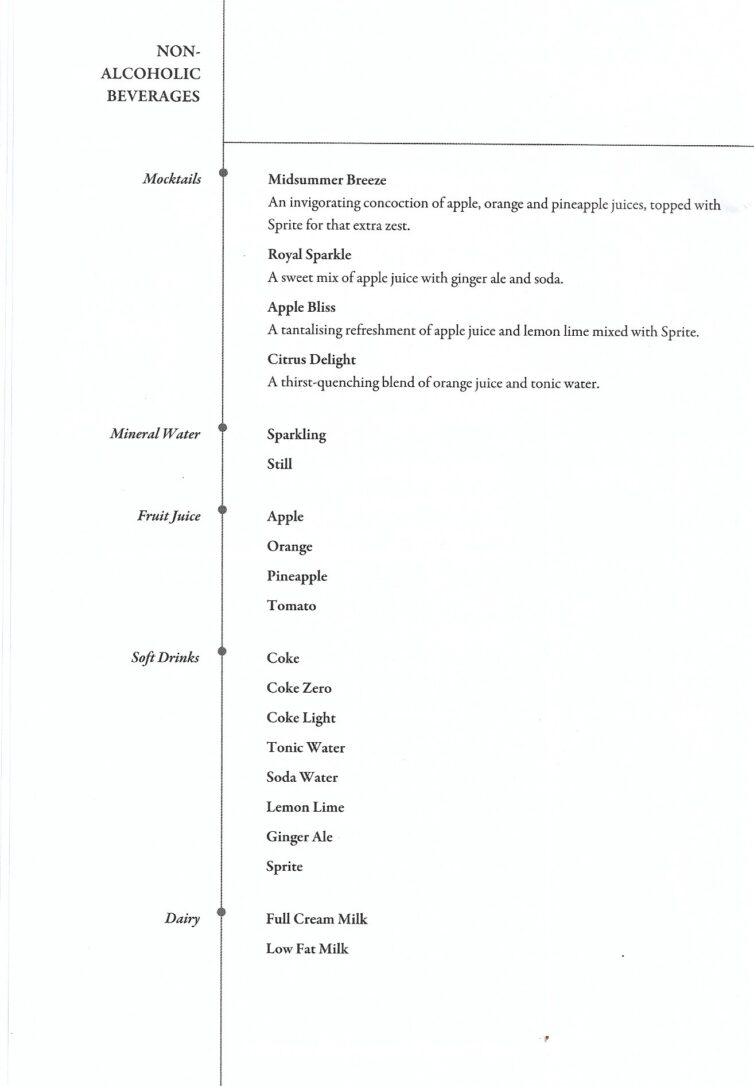
Singapore also stands out for a possibly best-in-class tea menu.
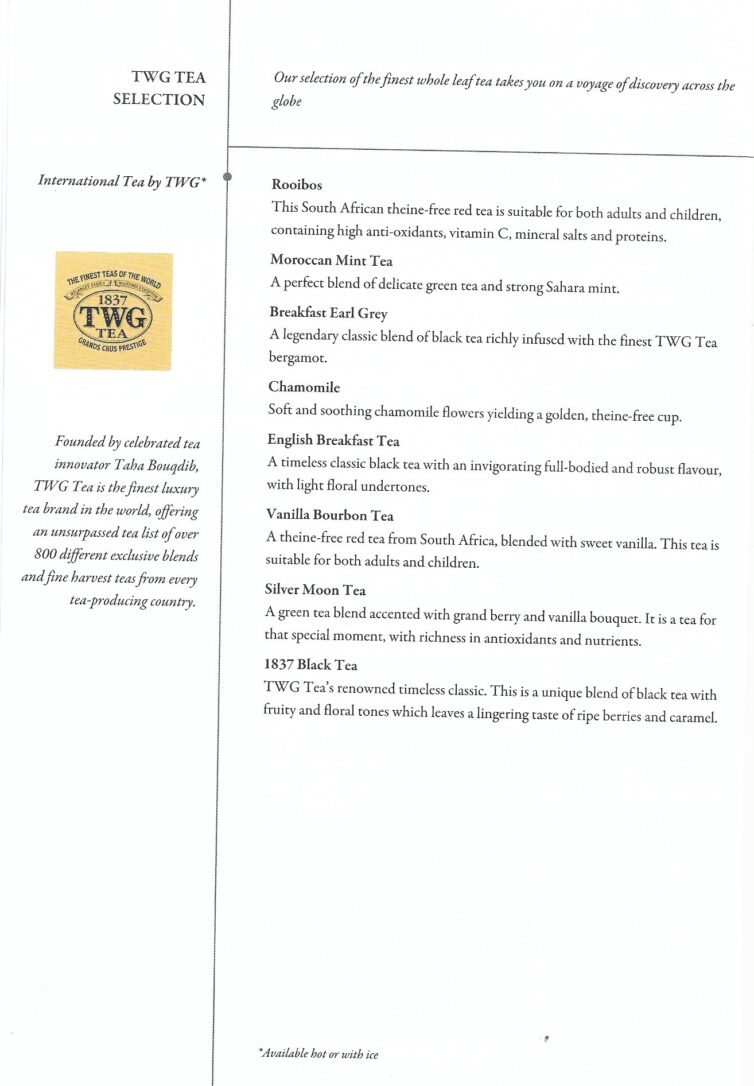
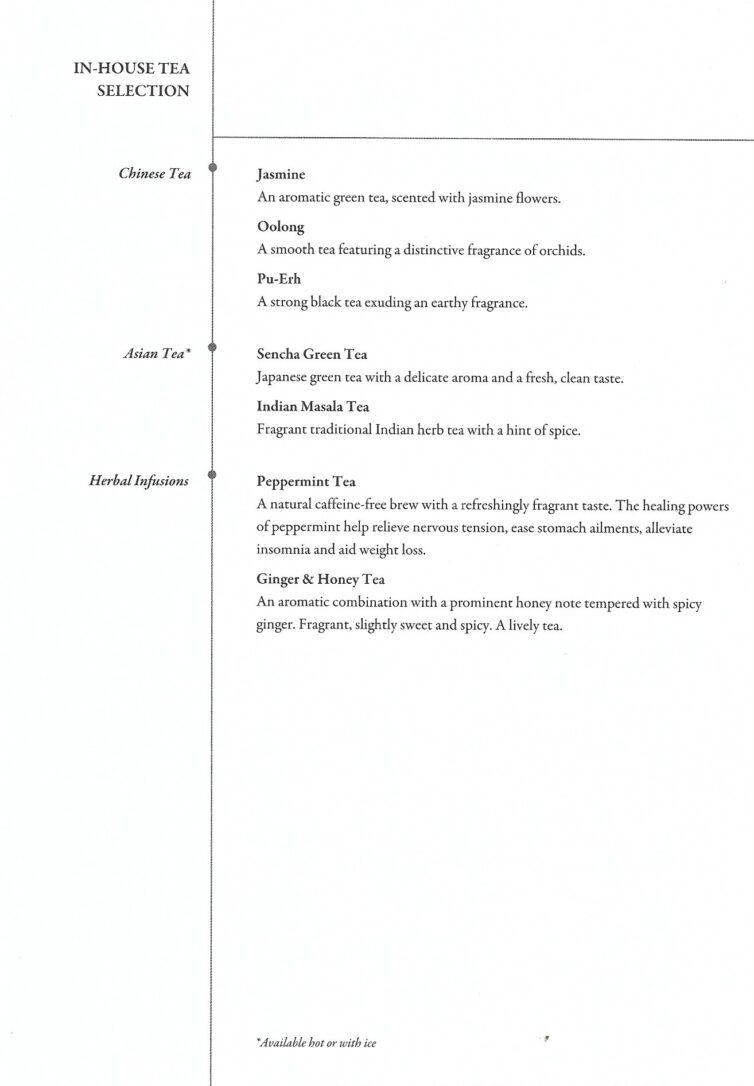
It also offers up multiple choices of Illy drip coffee.
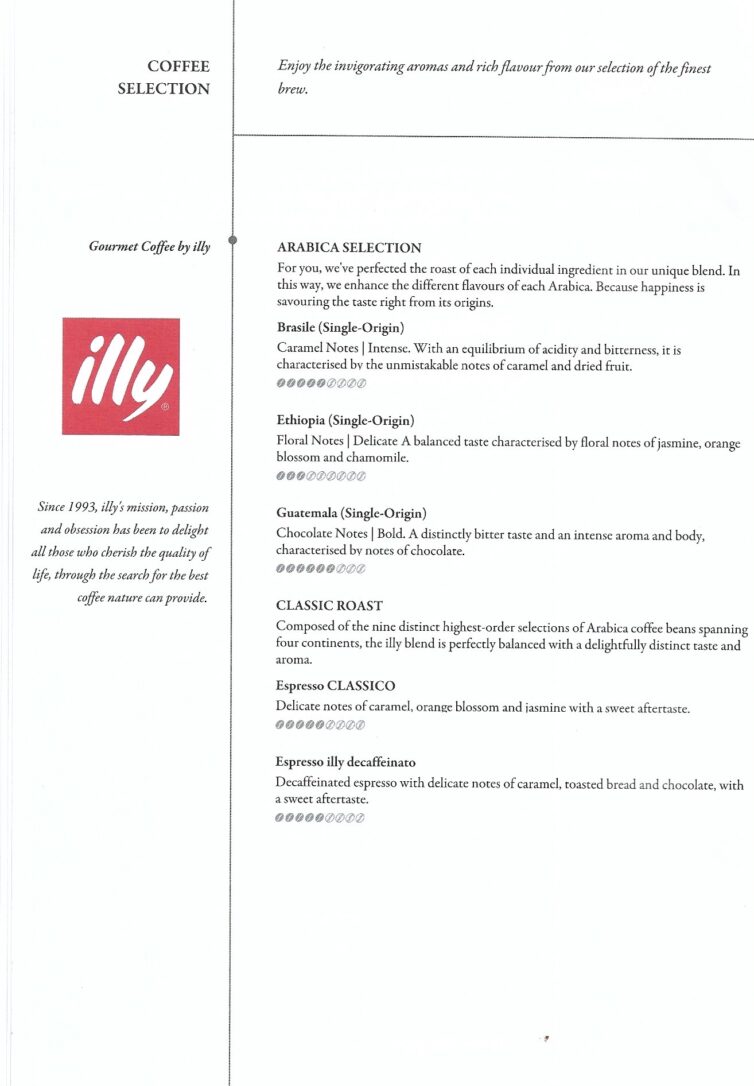
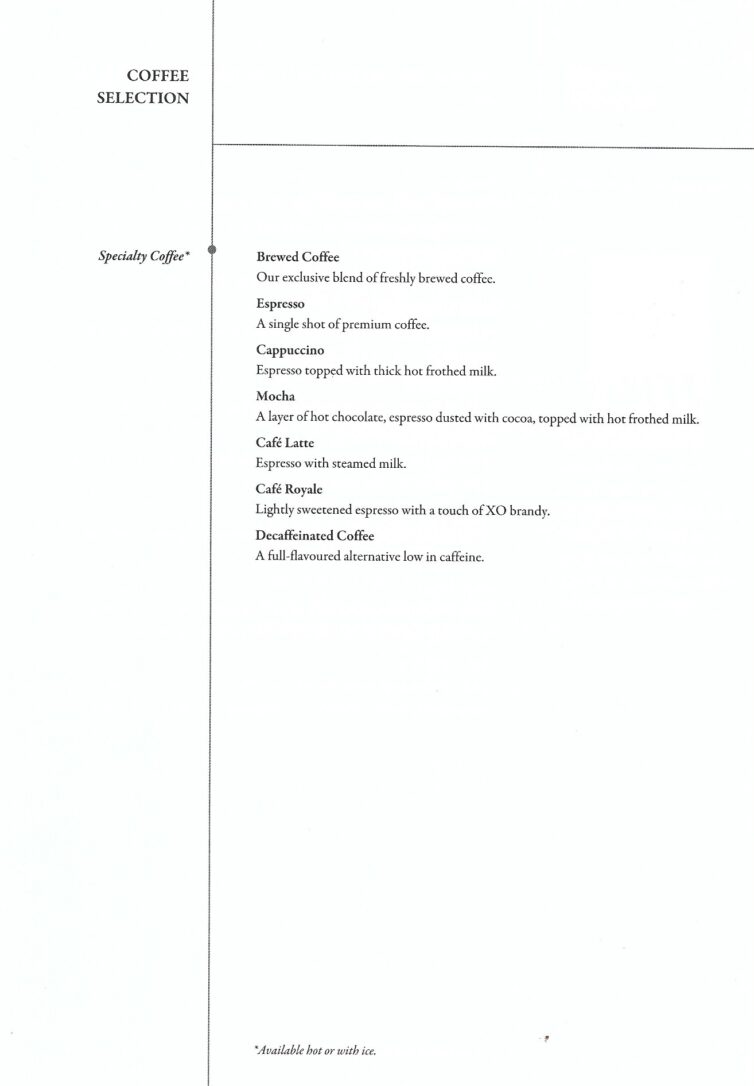
Switching over to Qatar, the airline also offers a competitive drink menu.
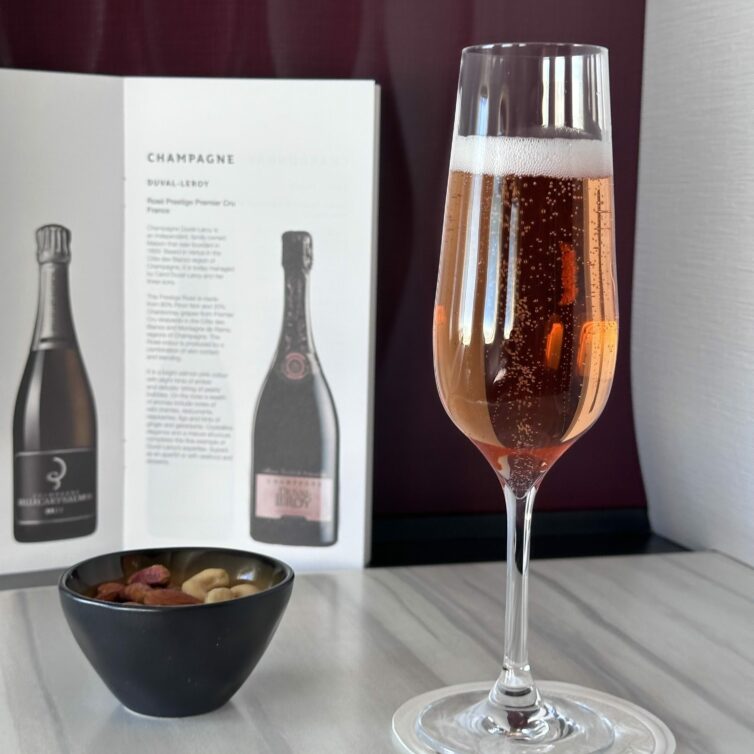
The Billecart-Salmon champagne it served was impressive, though maybe a half-step less elite than what Singapore was pouring. To its credit, Qatar’s menu had a separate rosé champagne option.
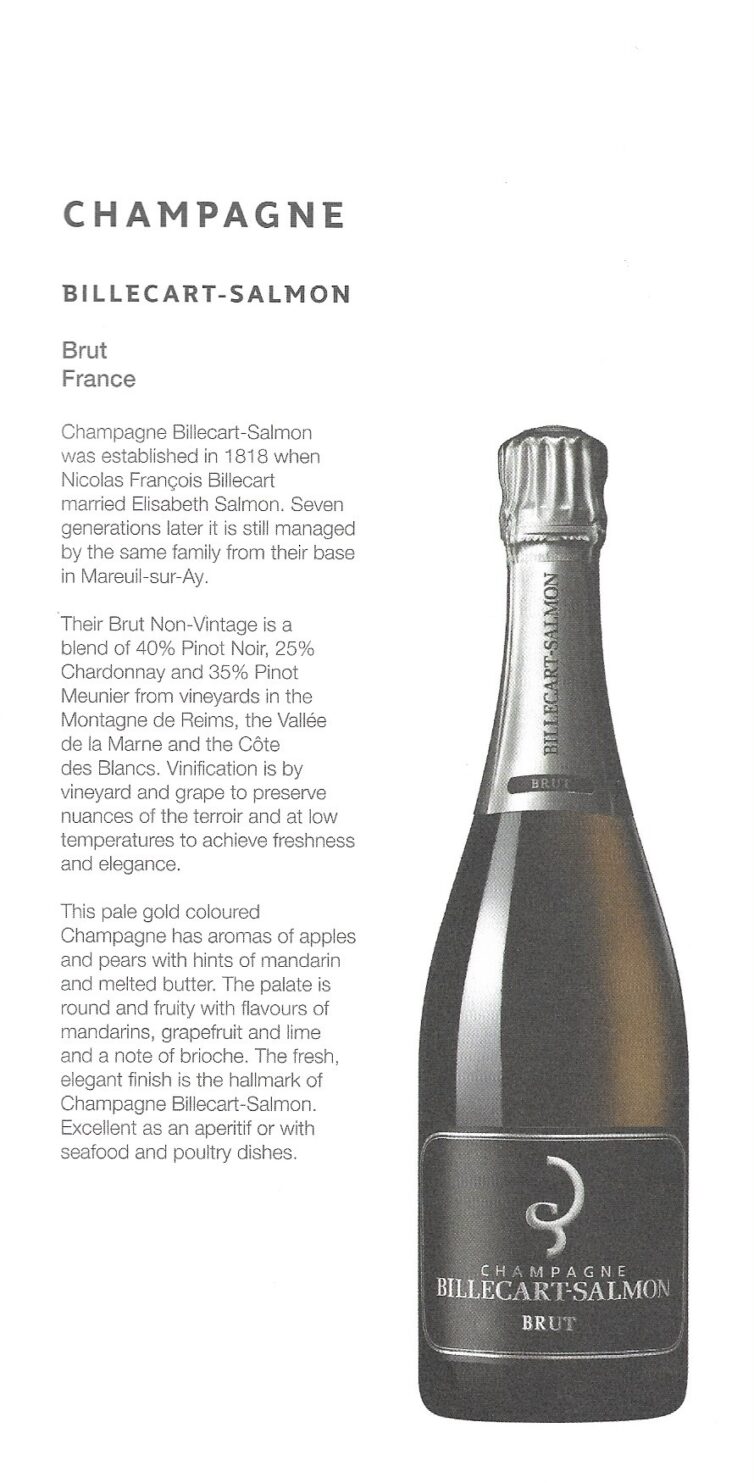

Qatar offers a competitive cocktail list and an impressive list of mocktails and other non-alcoholic options.
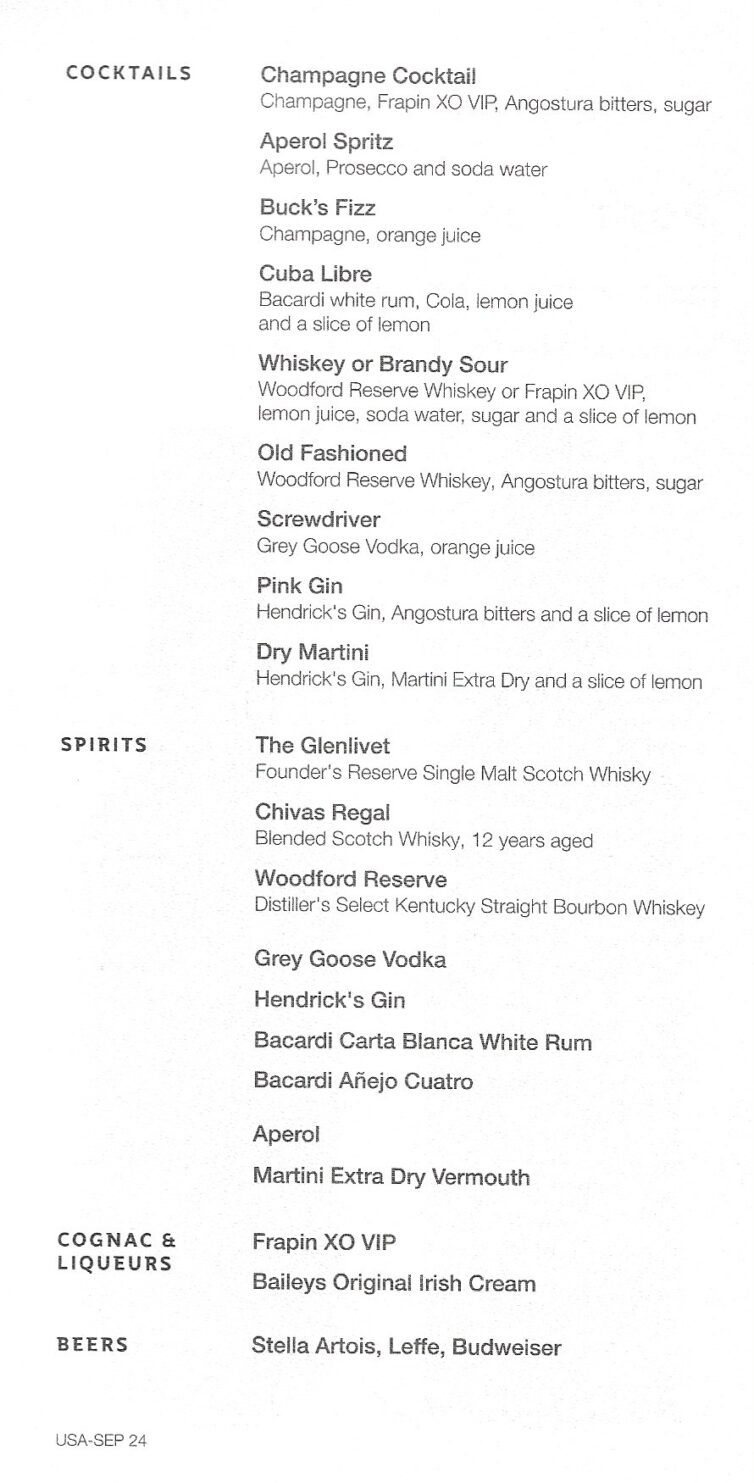
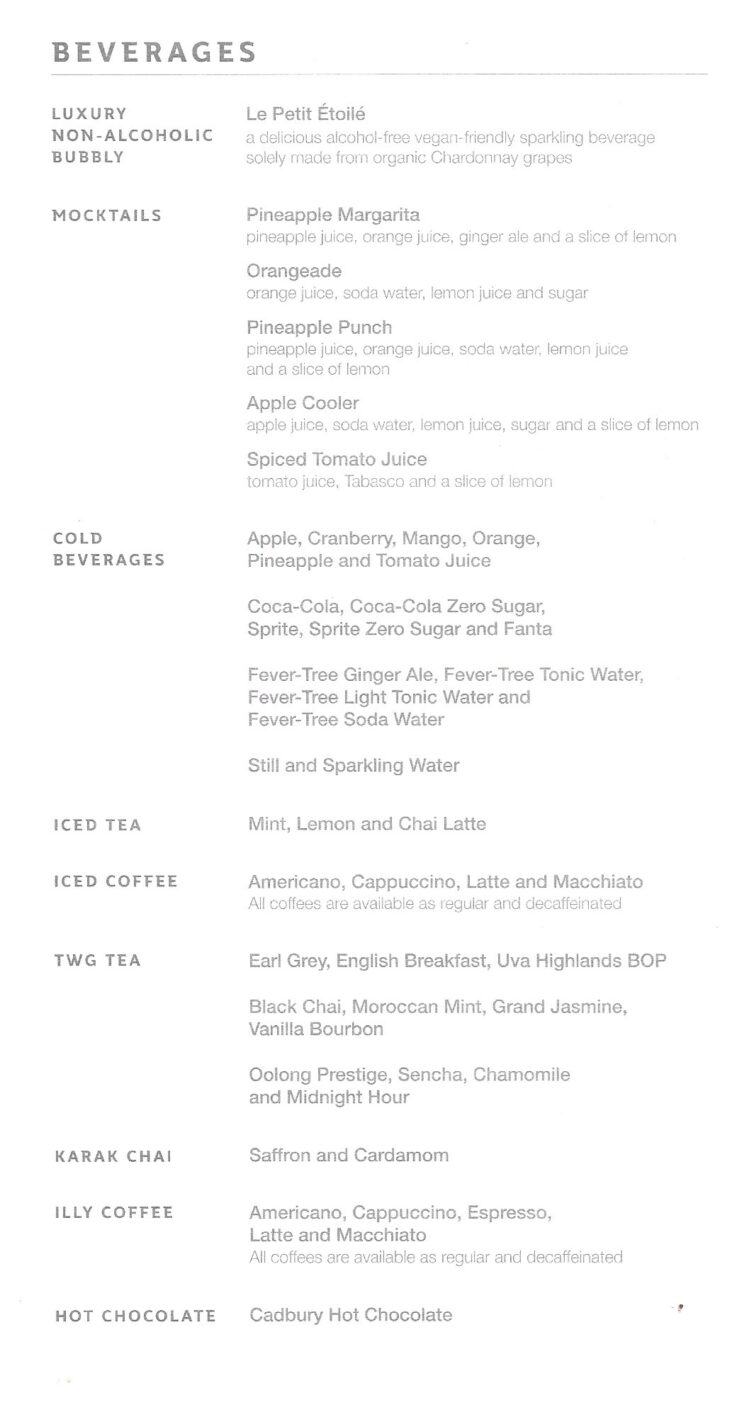
The Winner: Singapore
Raise a glass to Singapore Airlines, because it’s the winner here. It has a slightly better headline champagne, a bit more local flavor to its cocktail list, and also impresses with its diverse coffee and tea selection.
Amenities
Time to talk creature comforts. Along with a packaged towel, Qatar leaves an amenity kit at each seat. Since 2022 its kits are from French luxury brand Diptyque.
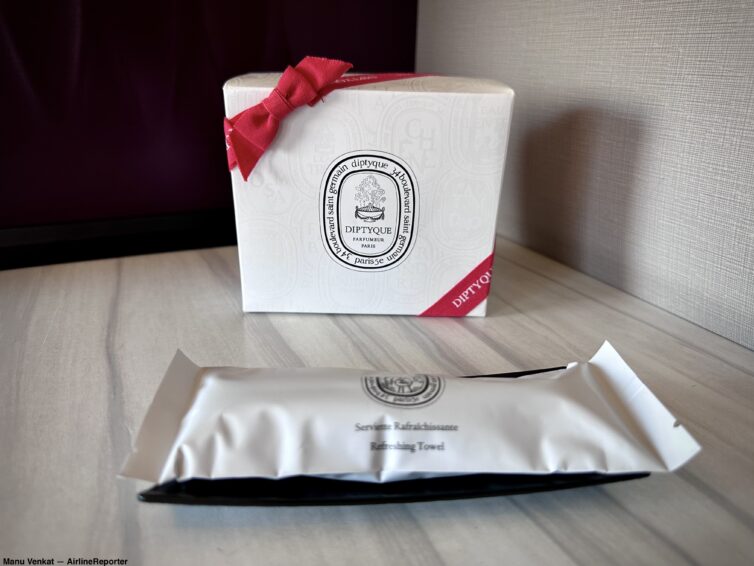
The kits cover the basics and then some. In terms of quality, my wife (who’s better qualified to comment) loved the lotion and fragrance.
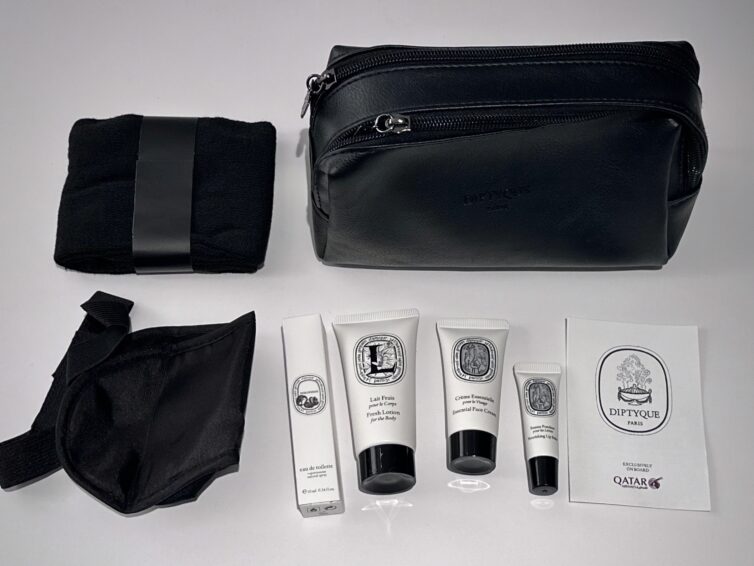
Singapore Airlines does amenities differently. For a while they didn’t offer amenity kits at all, though in 2020 they began offering basic kits and last year switched to Le Labo as the supplier. The contents are high-quality but more limited in the number of items as compared with Qatar.
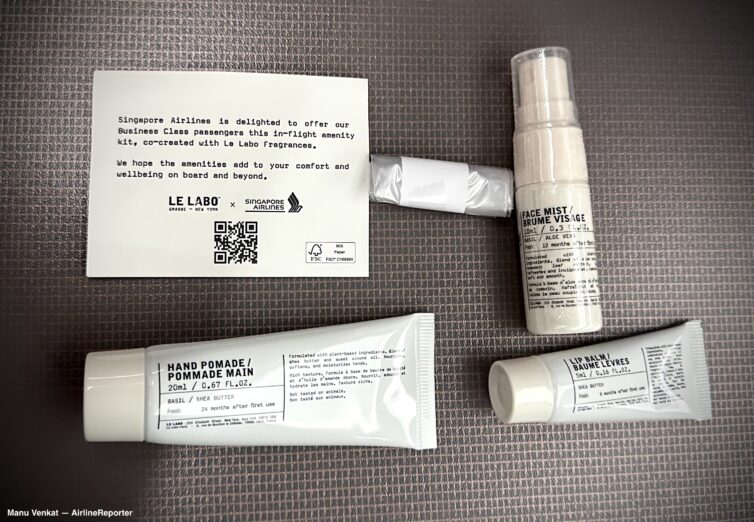
It’s not that Singapore is stingy, but rather that it does things differently. Instead of a fuller amenity kit, Singapore opts to keep the lavatories well stocked with toiletries like combs, shaving supplies, and dental kits that you can take as needed.
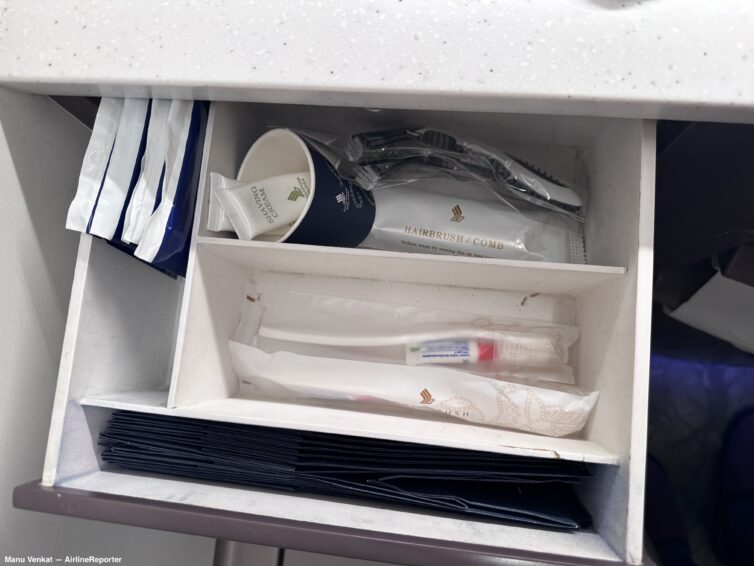
Winner: Qatar
First, I have to recognize that Singapore’s help-yourself strategy is less wasteful than standard amenity kits are. Eco-conscious flyers may prefer Singapore’s approach.
But I think many passengers expect that if you’re investing in a premium cabin flight you get a real kit, and in that regard Qatar satisfies expectations better.
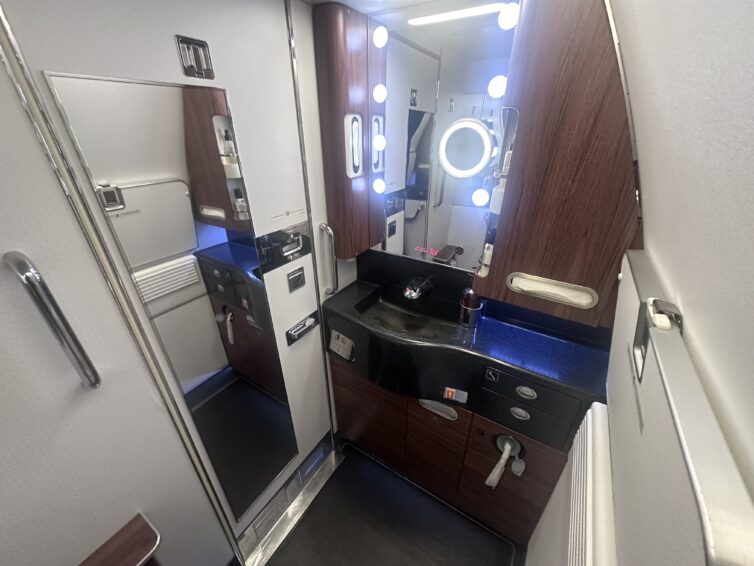
Crewmember service
Tangible items like food, drink, and amenities are important. But service is the glue that holds the inflight experience together. Both airlines’ flight attendant crews generally operate at a high level, though there will always be some person-to-person variability.
On Qatar there were a few instances when crewmembers were trying their best but were showing some strain. To be fair, the dine-on-demand model puts a ton of pressure on them. I can only imagine how difficult it must be to deliver a meal like the one below I had on the A350 flight from Cape Town to Doha, and to do it for a cabin full of passengers eating at different times.
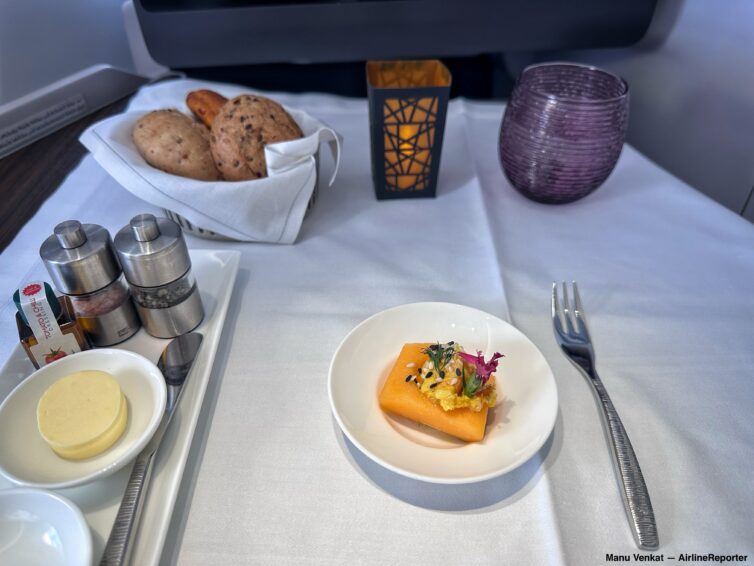
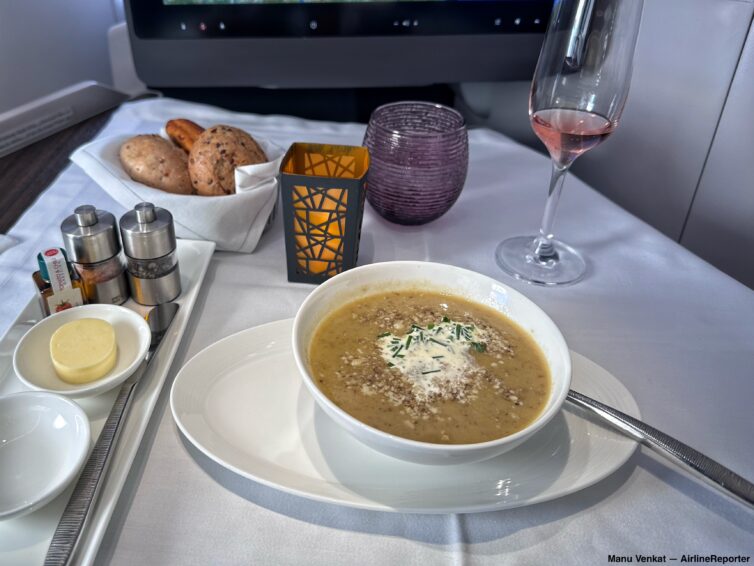
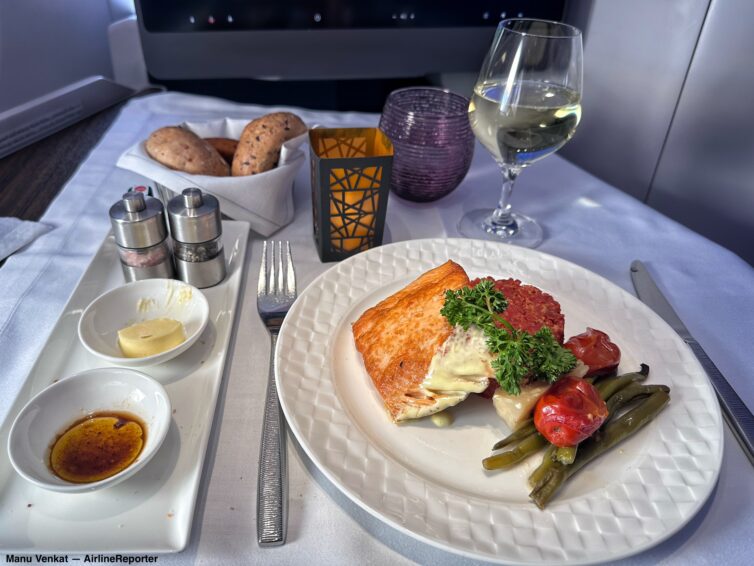
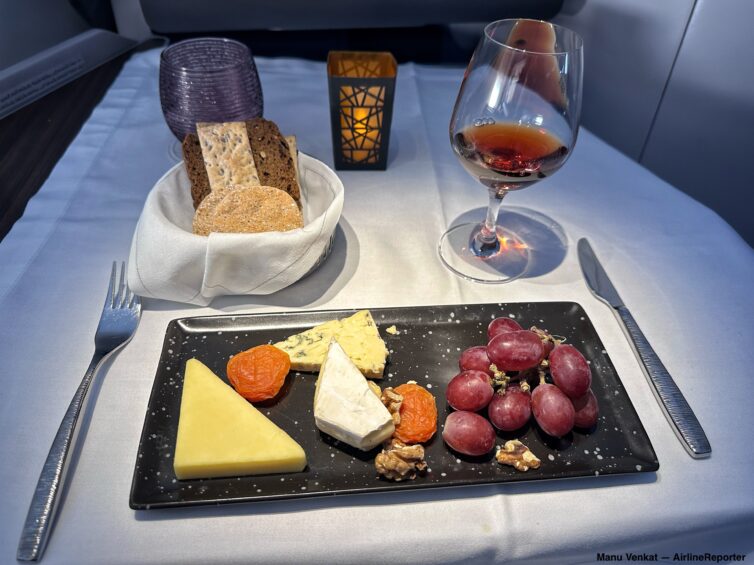
Anyone who has flown Singapore Airlines knows that their flight attendants are the most polished in the business, handling even the busiest moments of flights without breaking a sweat. The dinner I had on an A380 flight from Melbourne to Singapore (below) was possibly the most smoothly executed inflight meal I’ve ever had.
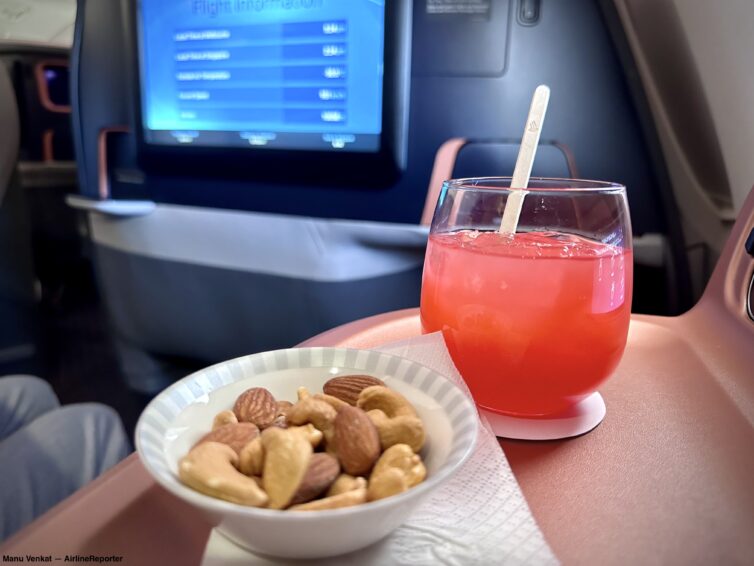
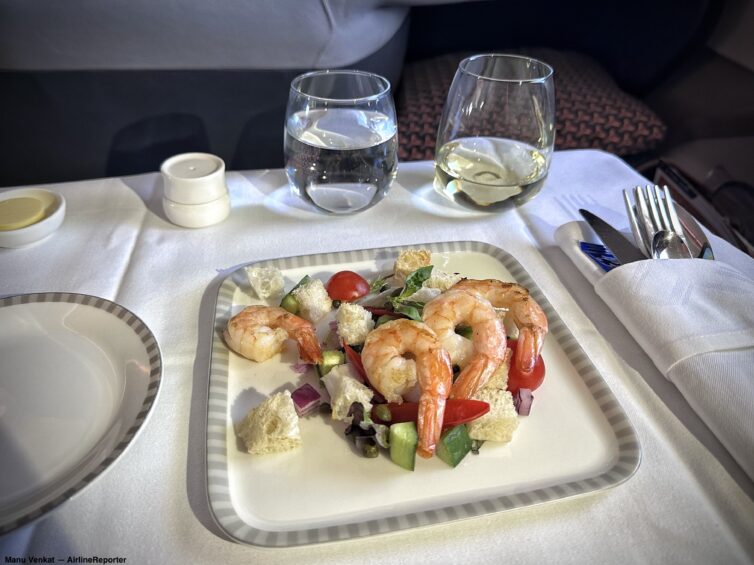
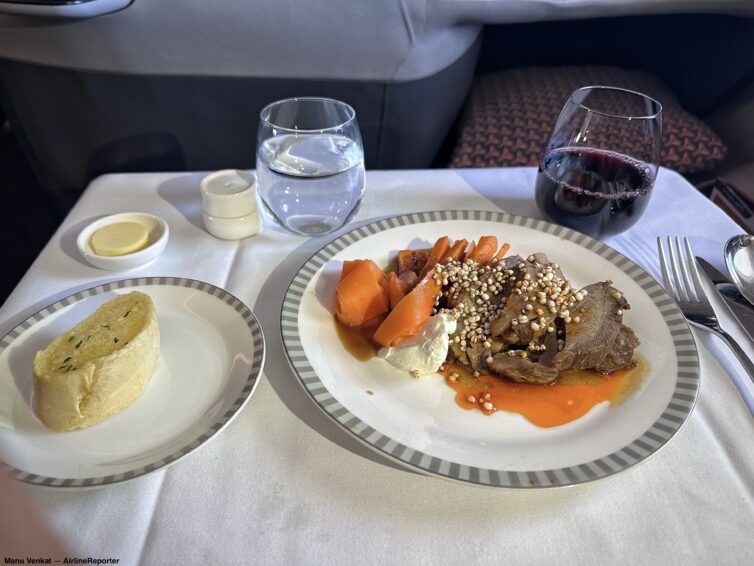
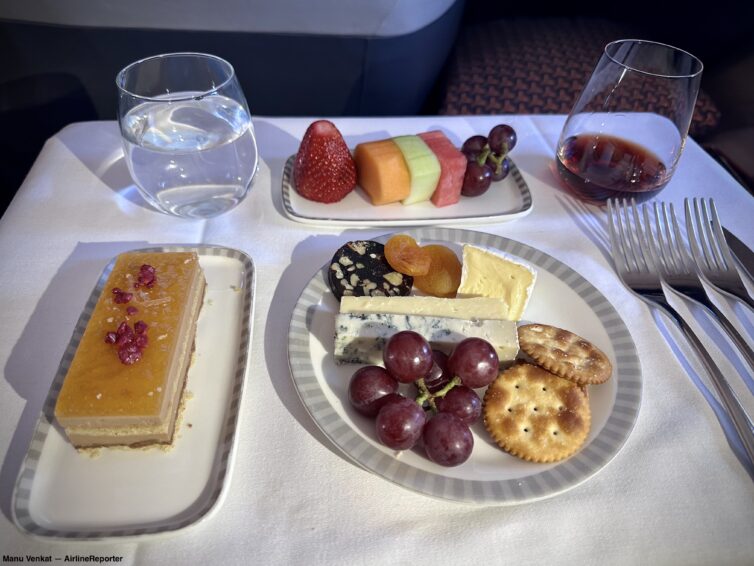
Winner: Singapore
On either airline you’re getting treated very well. But there was a bit more consistency to our Singapore crews overall, and they were especially good at making hard work look easy. You go, [Singapore] girl.
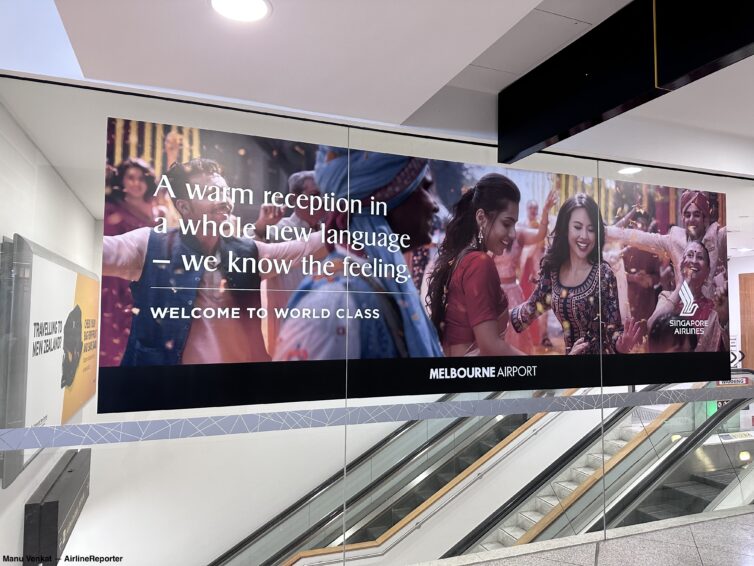
Inflight entertainment
On a long-haul flight, an airline’s inflight entertainment system has a huge impact on your overall experience.
On their ultra-long-range A350s, Singapore’s business class seats include a massive screen. The airline features one of the broadest menus of movies and TV out there.
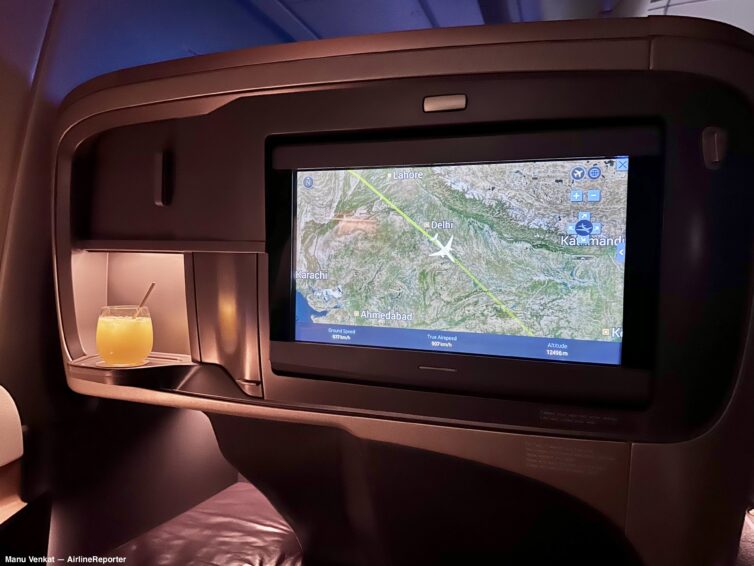
Strangely, the display isn’t a touch screen. I kept tapping the screen before remembering to use the remote instead. But you can also connect your smartphone to the system via bluetooth and use it as your remote, which worked well for me.
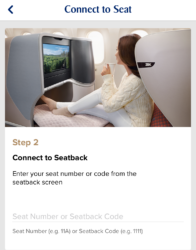
Especially since it was the world’s longest flight I used the moving map a lot. And Singapore’s was excellent. Zooming out to the view below really put in perspective how insanely long SQ23’s route is.

Singapore’s noise cancelling headphones are pretty good.
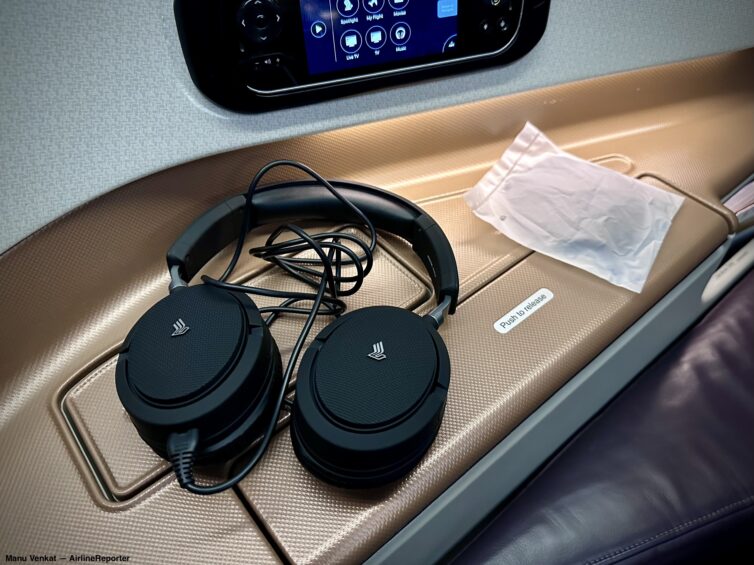
Qatar’s entertainment system on Qsuite also uses a large high-res screen. And its content library is MASSIVE.
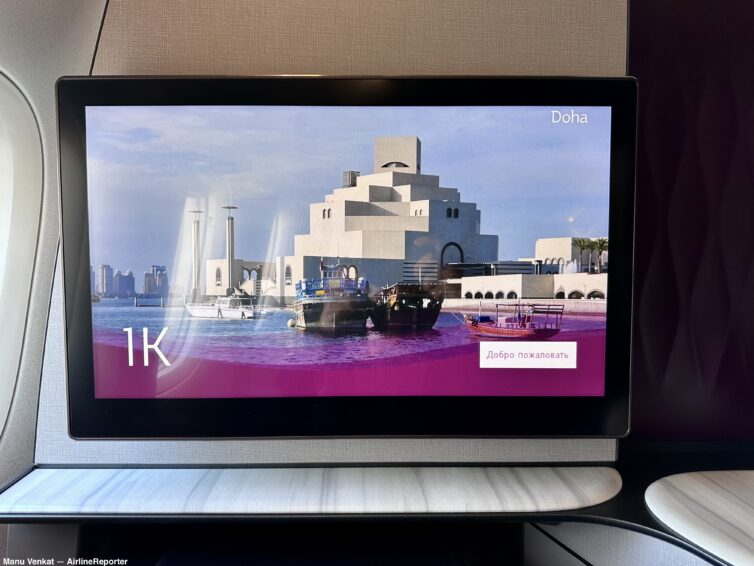
Qsuite passengers also get noise-cancelling headphones.
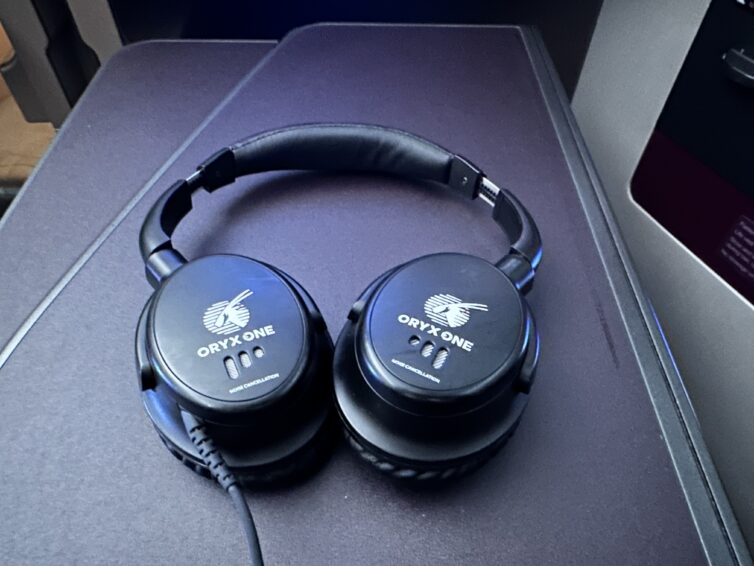
One area where Qatar let me down was the inflight map. The system felt at least a decade out of date and didn’t offer much passenger control.
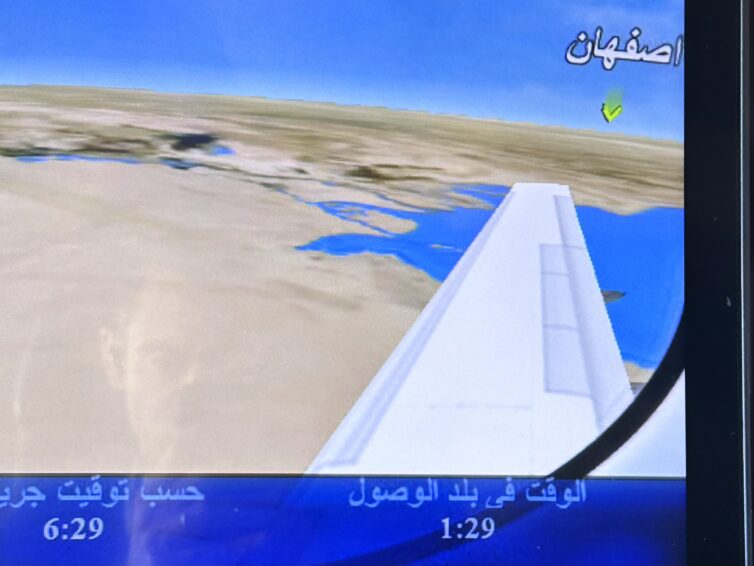
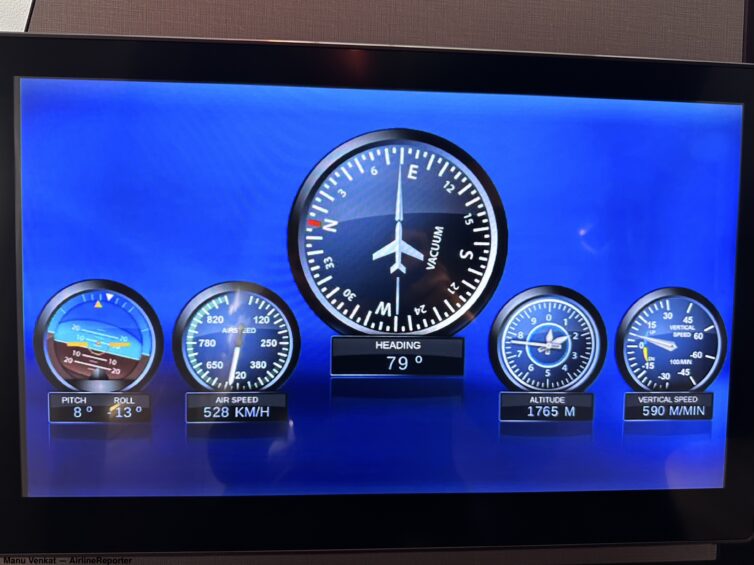
Winner: Singapore
This win was an especially close call. Singapore’s library of content seemed to offer more complete seasons, though Qatar’s was slightly larger. The screens and interfaces are both pretty good.
For me, Singapore’s free WiFi and better flight tracker map earned it the win, though in fairness some of Qatar’s newer aircraft offer a better map system than their 777s do.
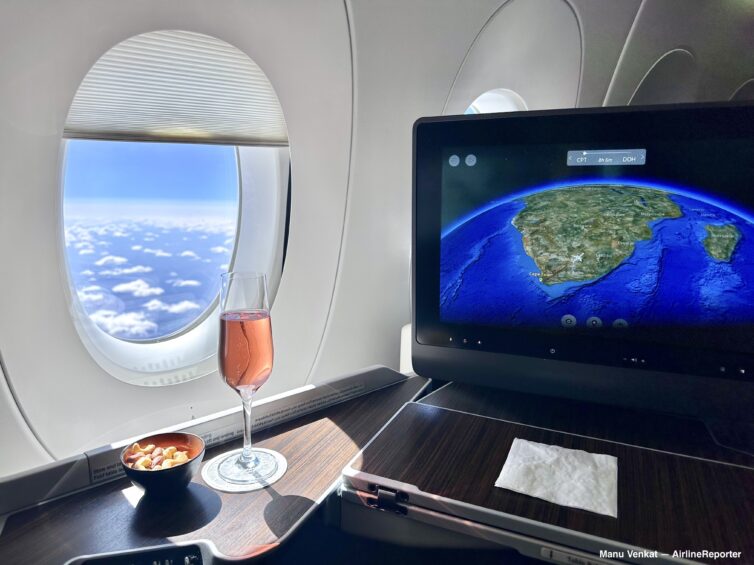
Singapore’s win in the entertainment + connectivity category may be short lived, since Qatar is installing lightning-fast and free StarLink WiFi across the fleet.
The ground experience
Though Singapore Airlines and Qatar Airways are happy to have you visit their home countries, the airlines primarily focus on long-haul connecting itineraries where you never leave the airport. That makes the ground experience at those hubs a major factor in your overall passenger experience. So the last round of our battle pits their home airports head to head.
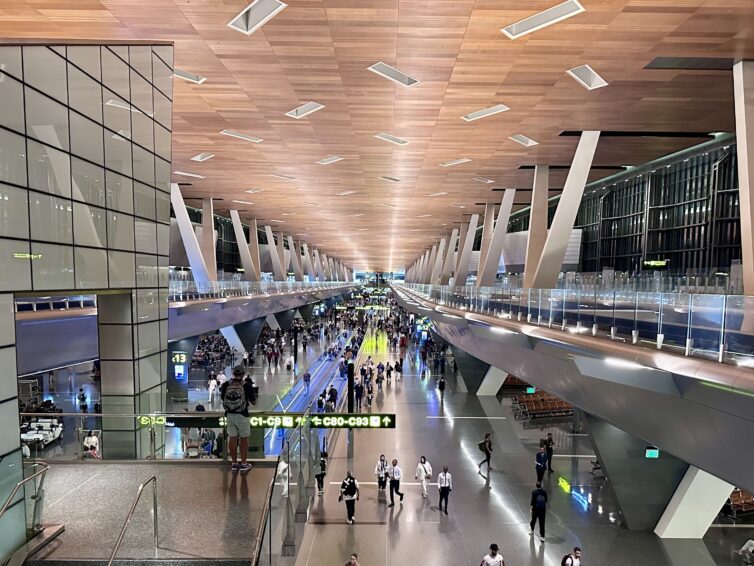
Doha’s Hamad International Airport consists of one massive terminal building. A walk from curbside to the farthest extent of the terminal extends exactly one mile. The current terminal opened barely ten years ago and it still feels fresh and new. It’s full of everything you’d expect out of a Middle Eastern mega hub: high-end shopping, multiple lounges, and some impressive art pieces. Whether you count the multimillion dollar Lamp Bear in the “impressive” category is a matter of personal taste. I never knew the line between creepy and cute could get so blurry… but I’ll admit the big bear grew on me.
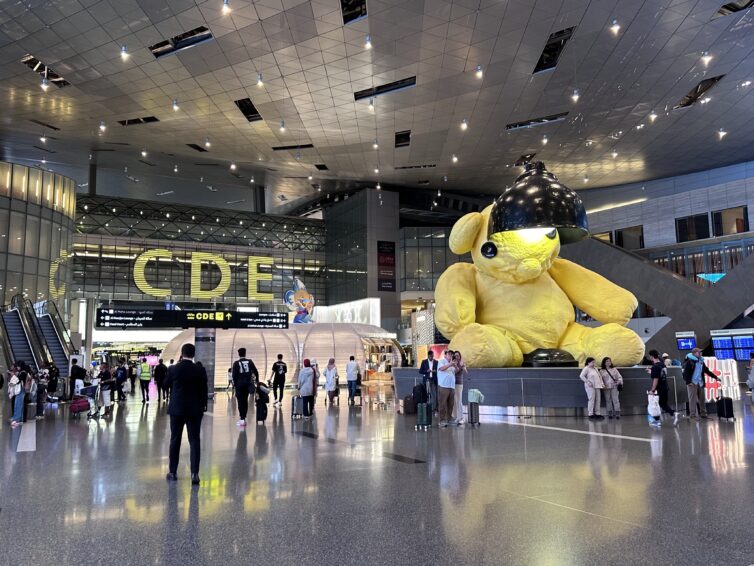
This story is a business class battle, and so the airlines’ lounges factor heavily in the ground category. Qatar’s Al Mourjan business class lounges are considered among the best in the business. The decor is sleek, modern, and overall stunning at both the original South lounge and the newer Garden lounge.
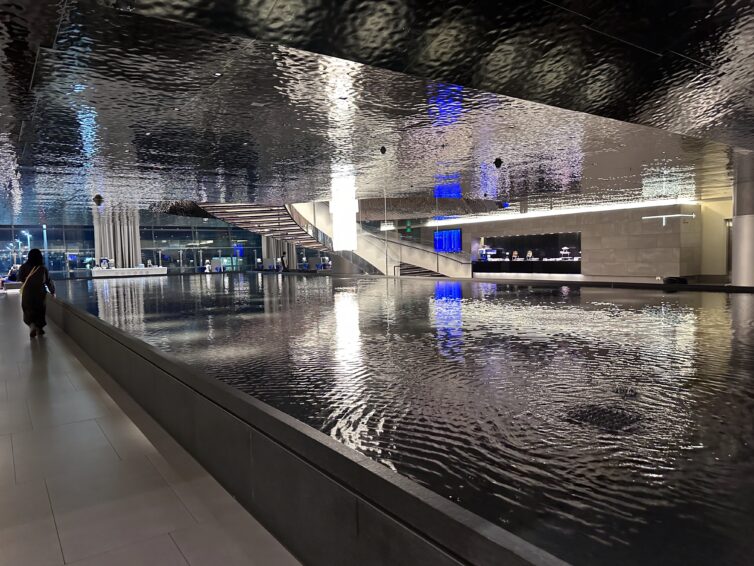
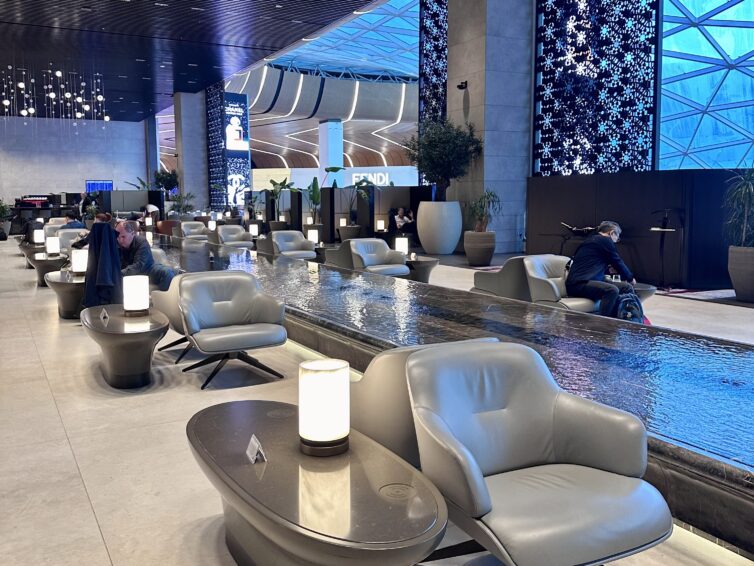
There are multiple self-serve food stations at each lounge.
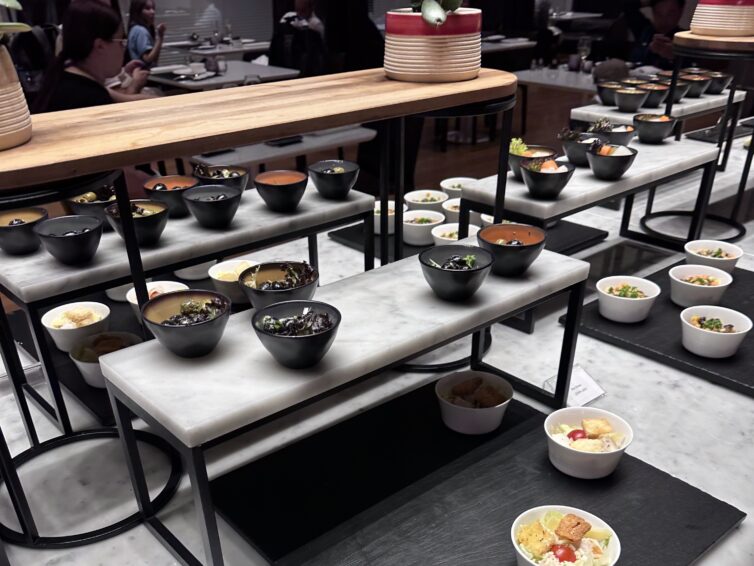
The South lounge also offers restaurant-style à la carte dining. You may need to wait a bit for a table here during peak times, but the food is excellent.
In terms of services and amenities the Al Mourjan lounges are top notch. There are plenty of shower suites if you need a mid-trip refresh.
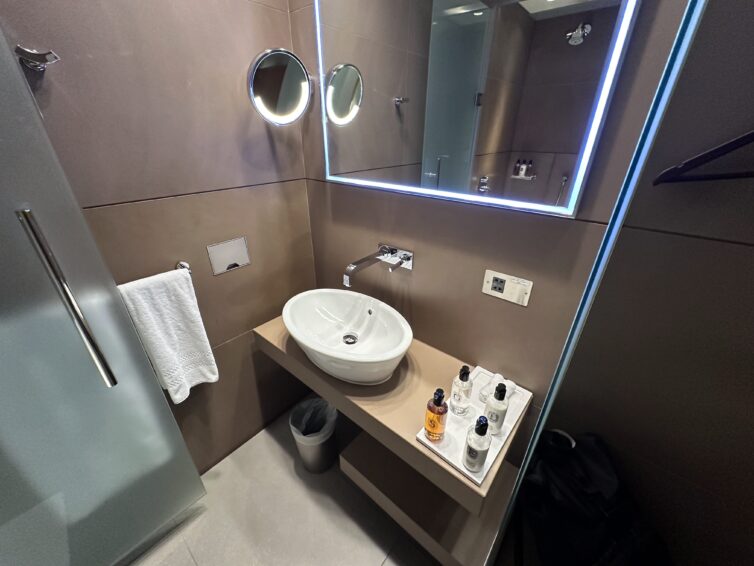
Both lounges also offer nap rooms, though the demand far outmatches the supply. Between three passes through Doha I only managed to get a nap room once, but I’ll admit the wait was worth it.
Over in Singapore, Changi International is about as strong a challenger to Hamad International as you can find. It’s a perennial favorite on global airport rankings. It handles a greater number of passengers, and is segmented into more distinct terminals compared with Hamad’s single mega-terminal.
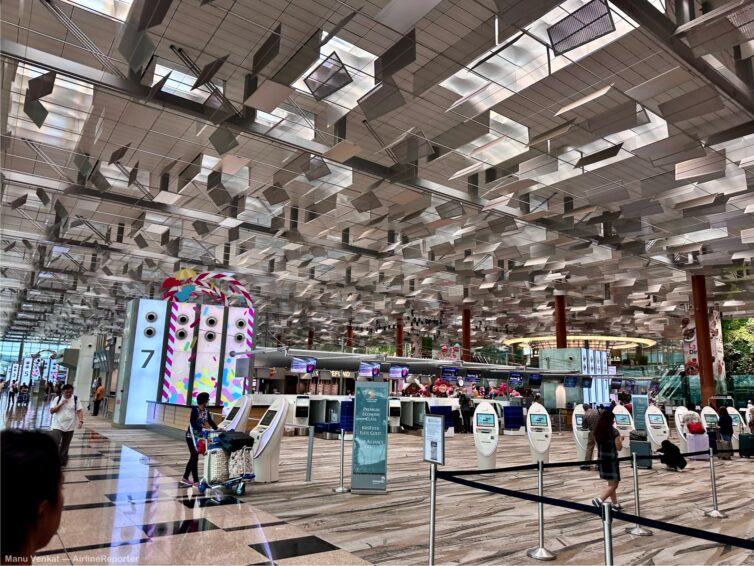
At the airport’s center is the Changi Jewel — a six-year-old $1.7 billion retail and entertainment complex with the world’s tallest indoor waterfall at its center.

While no other part of the airport can beat the Jewel, there are multiple other features that make Changi the wonderland of the airport world. There’s a butterfly garden, indoor climbing wall, and intricate play spaces, among a zillion other features.
As you’d expect, Singapore Airlines offers a pretty great lounge experience for its premium cabin passengers. It has multiple lounges across the airport’s terminals, with plenty of seating and tasty self-serve food options.
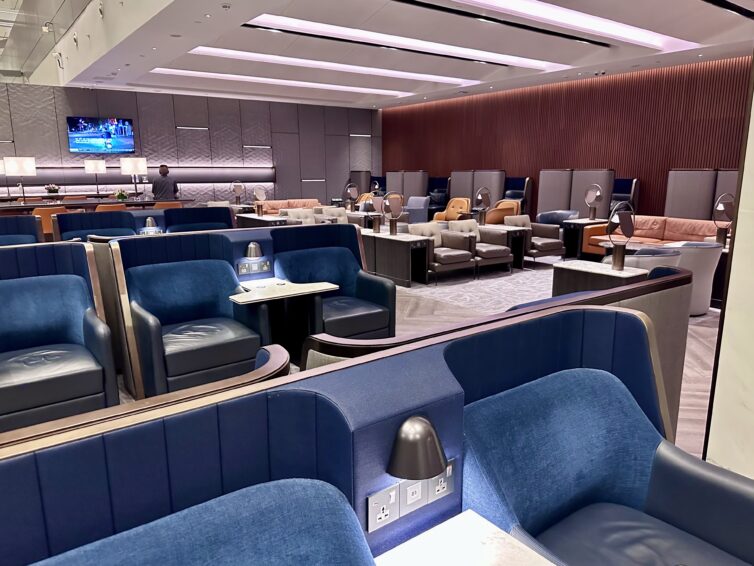
We found a nice nap area at one of the lounges, though space was first-come first-serve and hard to snag during peak times.
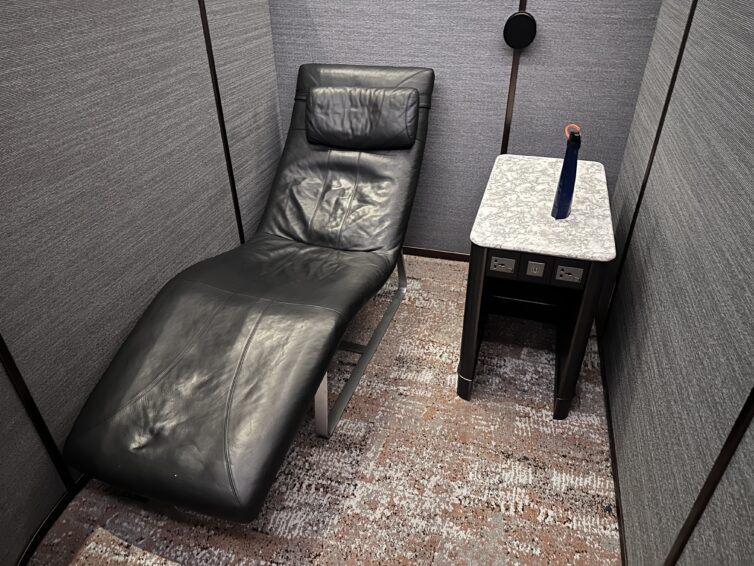
As you can imagine, every part of Changi Airport is kept spotlessly clear, Singapore-style.
Winner: Qatar
First, I have to acknowledge that Changi is my personal favorite airport in the world. For AvGeeks, SIN might as well be an amusement park. Why, then, do I give Qatar the win?
For premium cabin passengers, the experience at Doha feels a little more luxe. The main terminal is newer and airier. And Qatar’s Al Mourjan lounges beat Singapore’s flagship business class lounges hands down, in terms of design, dining, and amenities.
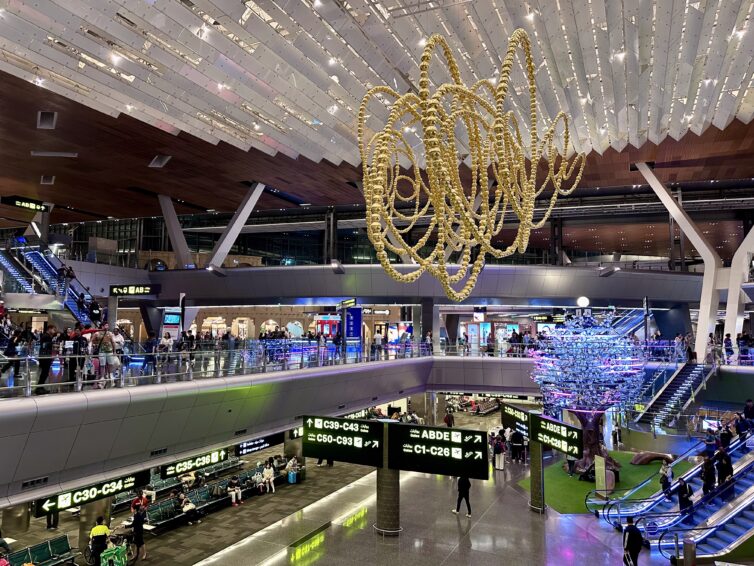
By comparison, as fun as Changi is, it’s an older facility. Many parts of the airport feel less spacious. And the design choice of placing security checkpoints at each gate instead of a central facility can be annoying.
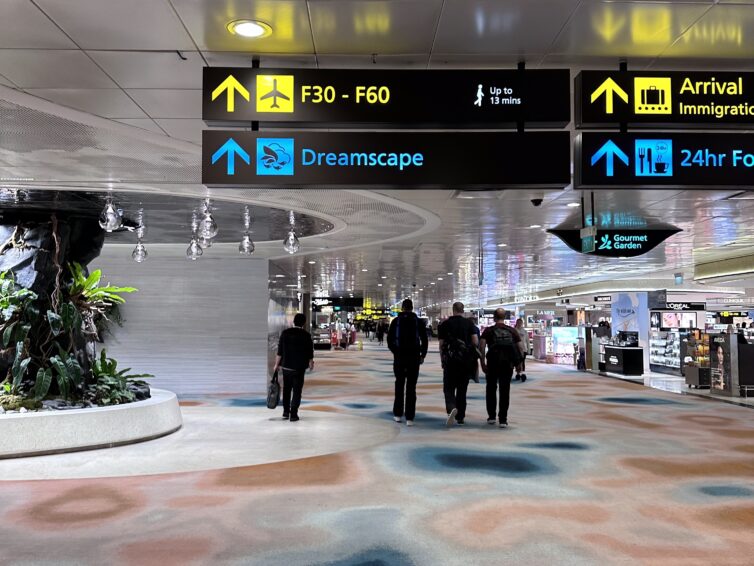
Changi’s Jewel is absolutely stunning, but notably it’s landside (AKA pre-security) and therefore harder to visit during a layover. By comparison, Doha’s “Orchard” (in the photo below) is airside and accessible to all transiting travelers.

If I was traveling in economy I’d pick Changi for all the fun publicly-accessible features that can make even a lengthy layover fly by. But in this business class battle, Doha is the winning hub.
Crowning a champion
If you’ve made it this far, you can appreciate how impressive both of these airlines are. Picking a winner wasn’t easy.
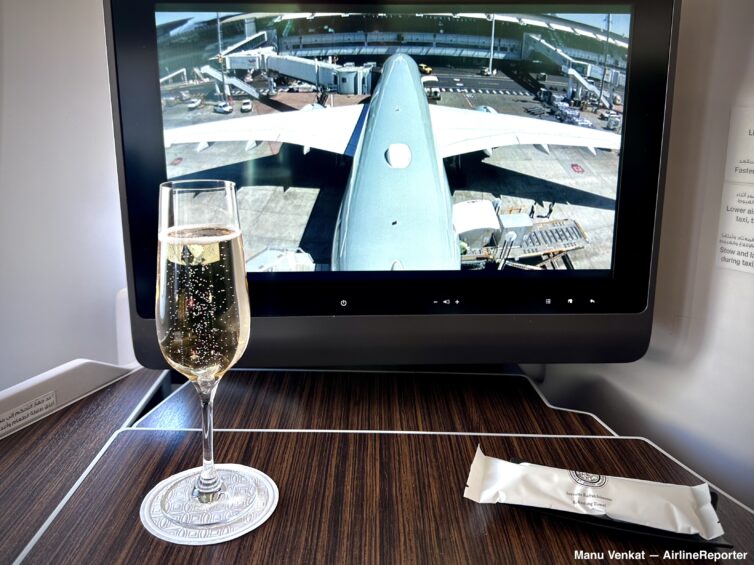
Based on the entirety of my experiences on each airline over the past year, Qatar Airways earns the overall win. Thanks to its strong Qsuite seat, its ambitious inflight dining menus, and amazing home airport, it deserves to come out on top.
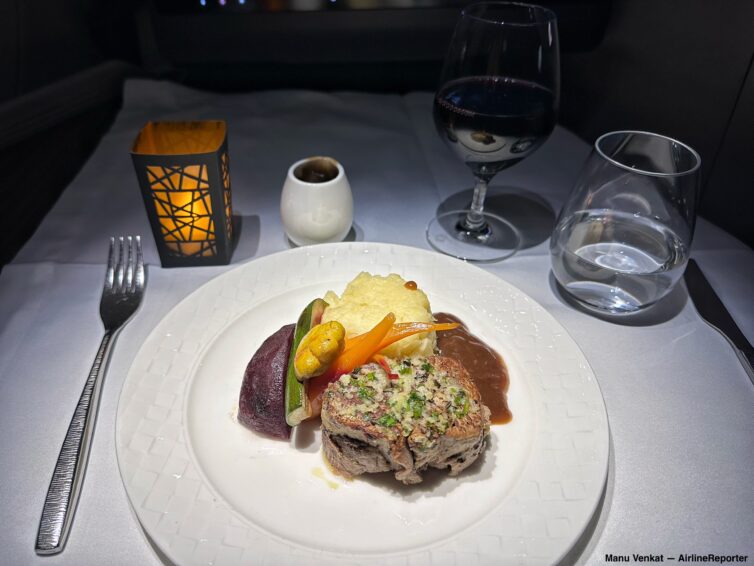
But there are two major caveats here. First: even if you agreed with my verdicts in each category of the competition, you might pick a different overall winner depending on how important each category is for you. After all, there were some areas like cabin service or beverage selection where Singapore was the better player. And if one of those areas matter most to you, then I couldn’t fault you for siding with Singapore.
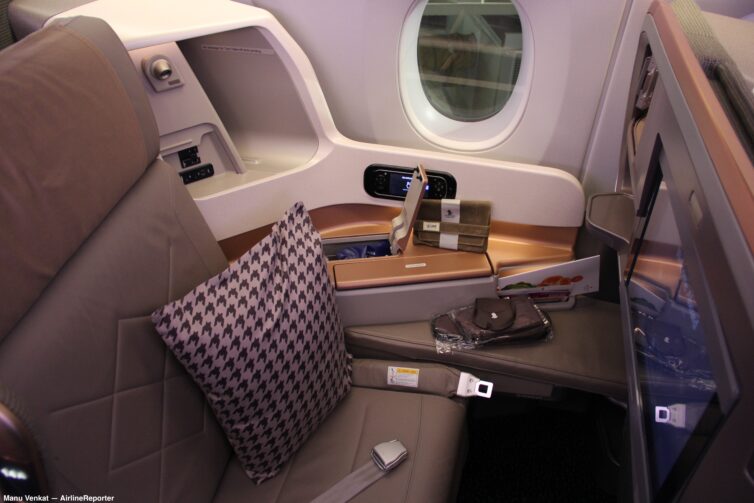
Secondly, it’s important to point out that Singapore has plans to address most of the areas where Qatar currently beats it. Just this year the airline teased some partial images of a new suite-style business class seat (with privacy doors) that it will start installing on its A350 long-haul fleet next year.
Changi Airport is also starting work on a MASSIVE terminal 5 that looks incredible, though we’ll have to wait until the next decade to see the finished product.

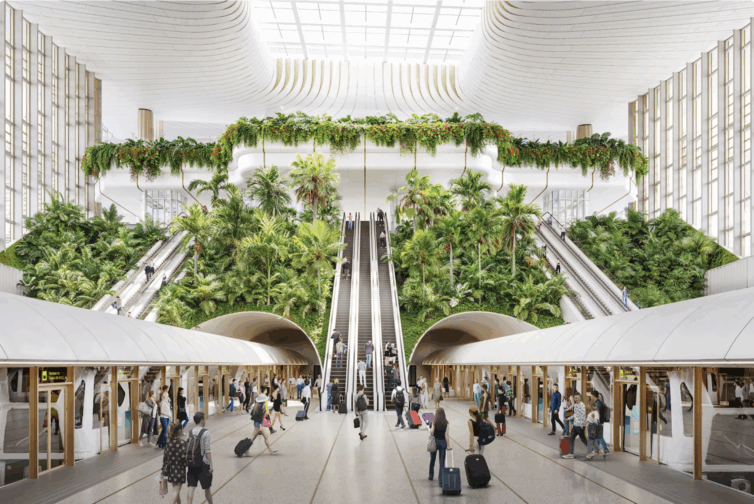
In the end, any airline’s win in the rankings is only a temporary one. And that’s a good thing! As long as airlines continue fiercely competing, we as passengers end up as the real winners.
And now for my favorite part of the story: where you get to share your take on this comparison. Feel free to disagree with me — honestly it’s more fun that way! Post your thoughts in the comments section below.
Undoubtedly Singapore airlines the best in every aspects they are top in handling the situation or pressure smoothly the world’s best airlines for its cabin service.
You got it right. Singapore Airlines and Changi Airport are the best in the World.
Brought to you by…. Qatar Airways
If you take the price of business ticket, Qatar is a winner. On some route, SQ can be 3 times more expensive…(SIN-CDG for ex.). Yes, stop over in Doha vs Direct flight. Does it worth 3 times more: no for many users.
Hi
My wife and I have flown with both airlines and we prefer Singapore which is basically a personal choice.
We love Singapores cabin staff and that I guess is the main reason we just prefer Singapore.
Plus we are in awe of Changi airport and I guess because we have been through it so many times it is easy to navigate and almost feels like home to us.
Loved your report – thank you – although I don’t know how you did 19 hours even in Business.
London or Paris to Singapore at 13-14 hours is our limit at our age.
Singapore rules😍
I agree with your overall assessment, but would differ on some of the individual categories, e.g. food. Both are amazing airlines, but Qatar has the edge, largely because it is not in any way constrained by the financial ability to invest whatever is required to be the best.
Qatar beats Singapore hands down on overall including the critical aspect of value for money – Qatar’s fares are far more competitive vs Singapore’s
Qatar absolutely takes the cake. No mention of wines aside from Champagne. Separate dining area from the rest area for Al Mourjan Business lounge. No clanging and banging of cutlery and crockery, which is so annoying. Warm assorted nuts with your first drink, which is my favourite.
It strikes me how much of an apples and oranges comparison this is, even between different aircraft in the same fleet. Recently flew business through Changi with Singapore. Business was a must because I’m too large to be comfortable in economy. I found the seats on the A350 I flew still too narrow and difficult to get into. Plus, the three point harness is completely too difficult to put on. As you said, it’s all subjective, but I’d honestly have the space they give us as a seat, rather than a capsule.
Hi. Great article! Just a minor detail to highlight: folding the seats flat is actually quite straightforward. I usually do it myself; and also putting it back upright. No difficult at all.
Thanks for that great pointer. From a passenger experience point of view Qsuite will still win as the most straightforward seat to operate, but good to know that especially if you’re a SQ frequent flyer and get comfortable with the seat you can operate it solo.
I was fine with whatever you wrote and your choice that Qatar Airways is the winner. What I couldn’t fathom is this, “And the design choice of placing security checkpoints at each gate instead of a central facility can be annoying.” This is the best in the whole world. Instead of thousands of passengers from many flights crowding the security area, the individual security is a major plus point. You breeze through the initial immigration procedure and deal with the individual security without worrying if you’ll miss the flight due to crowding mass security process.
Fair point. I do think that Singapore’s design means you have to leave the lounge earlier, to make sure you clear gate security. But I can see why some people may still prefer it that way. Thanks for sharing that point.
At the end of the day the thing that matters most is the comfort of the seats / flat beds. I flew 5 long hauls on both Qatar and Singapore in the past 12 months. Qatar is much more comfortable when it comes to where it counts. Bums on seats or in beds. A clear winner QATAR.
Based on current offerings Qatar’s Q-Suites with their privacy doors, and their business lounge leave SIA for dead. SIA’s business seats may be wider but aren’t that comfortable if you’re over 6 foot as the footwell means sleeping on a weird angle. Changi’s main business lounge is crowded & noisy, with limited shower spaces, though the Japanese toilets are a nice touch.
I have flown Business Class on both airlines (SQ MEL/SIN/JFK and back) as well as Qatar Airways (MEL/DOH/LHR and back). Both airlines are fantastic and really look after the Business Class passengers. However, my main bugbear is that both beds have a ‘tube’ for your legs to fit into, and I just feel so claustrophobic when I am trying to sleep. So on the 19-hour flight from JFK to SIN, I think I managed TWO hours of sleep… 🙁
Singapore is without doubt in front in terms of inflight service, lounges and customer service.Qatar simply dumps its passengers if there are flight cancellations and you are not in Doha. Customer service and support is non existent even though you are flying business class. The lounges outside Doha are very disappointing and certainly do not offer what you would expect from a business class lounge.
I have to agree with you that Qatar Airways is a sensible choice for No 1, but my opinion unfortunately is skewed due to the fact that I have experienced Qatar Airways’ Business Class product in summer/fall 2022 and summer/fall 2024 respectively, but have never had the opportunity (yet) to try Singapore Airlines’ Business Class (having only experienced ordinary Economy class product multiple times between 1990-2000, transiting through Singapore Changi (HKG-SIN-BOM roundtrip), although nonetheless still very impressed by SQ’s economy class experiences every SINGLE time.
My international 2022 QR trip was DFW-DOH-BLR roundtrip (my first Business Class trip ever in my 4 decade life), filled with flight delays and re-routing à la Qatar Airways (instead turning into DFW-DOH-DEL-BLR outbound from the U.S.), and having to fly Air India’s first class for the unplanned Indian domestic sector (yes even back then it was embarrassing, you could see holes in the carpet), and all because the inbound flight from DOH (to DFW) was delayed at Hamad.
I won’t add much to your excellent comparison of Qatar Airways and Singapore Airlines respective business classes, except on the subject of Doha Hamad Airport. I was not impressed by having to take shuttle buses whenever I was inbound into DOH (not outbound of course).
I was appalled at the chaotic transiting processes specifically security checks (and this was just a month before Qatar was hosting the FIFA World Cup).
I have to say I love, love, love being able to experience the QSuites during my DFW-DOH & DOH-DFW trips (and 2 yrs later LAX-DOH & DOH-LAX): having that priceless privacy was liking having my own little fancy fort for the insane 14-16hr flights I chose to subject myself to, to see family! The food I agree was hit & miss both in 2022 & 2024, but caviar being offered to a regular joe like me? It was sumptuous & well worth the wait (keeping in mind I don’t like/eat fish roe when offered it at sushi restaurants), it tasted like the fabled Osetra Caviar (I am guessing here) and was heavenly!
I was very impressed by the Diptyque products, and fully understood the luxury factor when I went to my Amazon app and saw how very pricy their full size products are! 😮.
I’m sorry this was so long, but well, it was important to my AvGeek avatar!
Thanks for sharing all those experiences RJ. And good point on the bus issue — I would have mentioned it except that Hamad recently opened a new section of the terminal which (I heard) reduces the use of the remote gates. I’d be interested to hear from someone who’s flown them more recently if they really are using the buses less now.
They tied to be honest, because it’s 4-4.
I preferred the Qatar QSuite too, though Singapore Airlines is also great. The Doha lounges are incredible.
We will fly from Singapore to Melbourne later in the year. Would Qatar go via DOH?
I have travelled to the UK since 2016 when Qatar started to service on the Sydney London Gatwick leg.
I have raved about this airline and would always use it on my trips. The meals, service, staff and once using QSuite were amazing. I am still a lover of the A380, but the 787 Dreamliner in business is quiet with limited seats on offer. Even Economy is excellent. Come on Qatar, get with the Premium Economy program.
Unfortunately, as of last week I have so disappointingly moved across to try Singapore.I hope I am not disappointed.
DO YOU WANT TO KNOW WHY? Qatar are now charging for your choice of seating $150 per leg. I don’t think so when the cost is just under $10,000 return ex Sydney. Why did you have to get on the greedy bandwagon!
Thanks to everyone who commented so far — we read them all, we promise. Keep them coming!
I have taken a Sing Air flight from LA or SF to Singapore the past couple of years. My only gripe is with the wifi. It often disconnected and was very slow when it did work.
I have only ever flown with Singapore Airlines and coming from Sydney to London Heathrow on Economy flights untill l tried Buisness class then l never looked back as it was the most amazing experience ever 👍
The service was impeccable, all that has been previously said by others had been the exact same for me .
Then l had to start using assisted travel with them as l can know longer walk very far, and for me this is where they truly sprung into action l was treated like a first class passenger on a buisness class ticket 😊👍
Next year l am looking at flying SYD- SIN-JFK & return. l was looking at flying with Singapore Airlines but l have been told there will be a 11 hour Layover in Changi Airport??
Is this correct or have l got this wrong . Loved the report 🏵
I fully agree with the comparison, as I have travelled in Business class with Qatar & Singapore. Qatar Qsuite is better than SIA. My vote is for QA
When they deliver both airlines are up there with the service they provide however,
Last time I flew Qatar (business class) I arrived into Doha to be informed my connecting flight to Singapore was cancelled and I had to wait for the next one? Next day…. I had a Scoot flight from Changi airport to Jakarta for a hotel stay and meeting the next day…. Qatar customer services advised as it was not a Qatar flight the problem was mine…. I advised I had left more than the minimum time between flights to connect and the problem was theirs. I ended up sleeping on a settee in the business lounge not knowing if I would make my meeting. Following morning Qatar eventually conceded and put me on the direct Jakarta flight though I refused to pay the flight difference they said I should. I made the flight but no matter how good the aircraft, the meal or the seat when they screw up and blame the customer…. Singapore not much better they changed a plane to one with no premium economy seats but “offered” to keep the seat next to me free which was just as good…. When I said no they offered that plus a voucher to upgrade to PE in the future, I said no book me on emirates, they folded and bumped me to business. Again no matter how good the business class service is it is customer service that puts me off. I have not flown either airline again in 10 years and never will. Emirates all the way.
You think of the quad feature as a novelty. The innovative design allows groups of two, three, or four people to travel together in their own private mini-cabin. I travel frequently with my spouse, and we really enjoy being in a two-seat mini-suite.
Half the seats are rear-facing, which I thought would be a problem as I get motion sick very easily. I can’t read while in a car or bus, for example, and I get carsick if I’m in the back seat of a car or a seat without a view forward in a bus. But I find rear-facing airline seats to not be a problem, except briefly during taxiing.
Personally, I find the enhanced privacy of QR’s Qsuite design is phenomenal. Many other airlines have adopted suites with doors for business and first class product, but aside from the Qsuite, they all have too-low walls, and most have doors that don’t fully close. The low walls make these products just a gimmick, without much real benefit. Since SQ’s seats aren’t suites, I wouldn’t say the contest is at all close; I’d say QR wins by a lot. A wider seat doesn’t counter the extra privacy.
You write that the decision to have overhead bins above the center seats makes Qsuite cabin look cramped. Only their B777s have overhead bins above the center seats; their A350’s do not. I’ll concede that the A350 cabin looks more open and airy, but my experience is that the 777s provide a more enjoyable experience: first, due to the lack of anything within reach overhead, the A350s do not have individual air nozzles over the center seats. Since QR, like many airlines, keeps their cabins hot, the nozzles are most welcome to those who find hot cabins uncomfortable. Second, the extra bins means there is rarely bin contention (except for the first two rows of a 77W, which has no bins due to the flight crew rest above). In my experience, bin contention on QR’s A350s is very real but also highly variable. Some flight, everyone seems to have checked most of their bags, carrying on only a small satchel, while on many other flights, bin fights are frequent. I’ve seen passengers nearly come to blows. Typically, someone in a middle seat fills the bin over the window seat, and the window seat person demands that they remove their bags, seeing the bin over their seat as their personal space. Third, there is a better ratio of lavatories to passengers on the 777s, which means less waiting for a lavatory (especially when everyone is changing into PJs after take off or changing out during approach).
I agree QR’s food execution is spotty. Ive had amazingly delicious food and some awful stuff. As for dine on demand, while I almost always eat at “normal” times (an hour after takeoff, and 90 minutes before landing), there are times I want to sleep right away and eat later. The flexibility is nice, and I do see that there is usually a few passengers taking advantage of it. I’m surprised you said this was a draw. SQ’s turning on the cabin lights for a meal service at the halfway point seems terribly intrusive. People may have just gotten to sleep then; it’s quite rude to subject them to light and noise.
By the way, neither airline offers what I’d call a good tea selection. I find the quality poor and the selection weak.
Regarding IFE, I find QR’s noise-cancelling headsets to be pretty bad. I bring my own and use them. I also find QR’s content selection to be quite limited, and very few of their movies, and virtually none of their TV shows are captioned (I prefer to watch content with captions as it makes it easier to catch dialog, especially in a noisy environment such as in flight).
The central Al Mourjan lounge also has order off the menu options in addition to the buffet. You scan a QR code at the table to see the menu, then tell a waiter what you’d like. The garden Al Mourjan is newer and frequent flyers say they prefer it, but be aware that its shower suites do not have toilets, while those at the central location do. As an aside, I never saw the point of the bear lamp.
I’m surprised you didn’t mention pajamas. QR provides them on long-haul overnight flights, while SQ does not. It’s much nicer to wear soft comfy clothes for long flights, makes for easier sleep, and keeps one’s street clothes fresher.
Those are some great points, thanks for that comment. Also good call on the pajamas. Qatar already won my amenities category, but I should have mentioned the pajamas in there as an additional amenity win.
Qatar is a clear loser and here is why.
They often rug you on QSuite by changing aircraft from Qsuite to non-Qsuite business with no compensation. Now when you add this to the mix they don’t come close to Singapore. Qatar has this problem of not necessarily getting what you pay for.
When this happens they offer a free change within 21 days back to Qsuite but really – is that going to suit your travel plans?
Steer clear people. Things are not always what they seem.